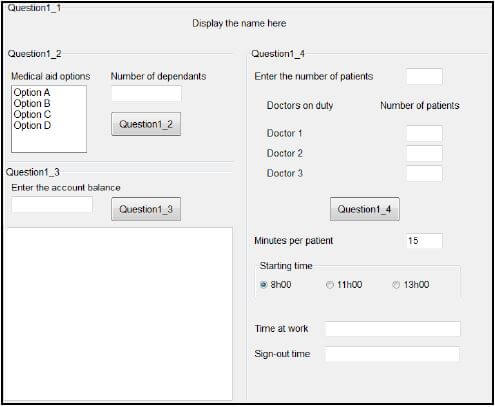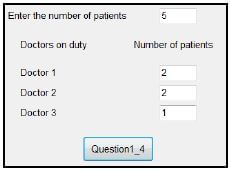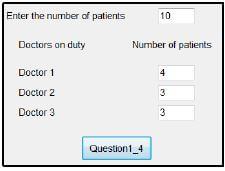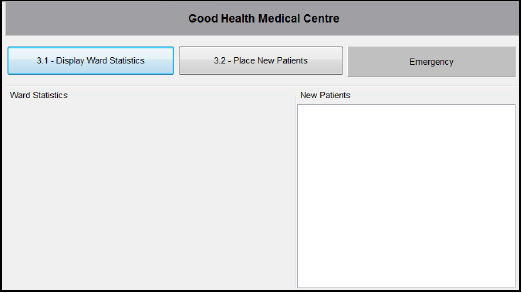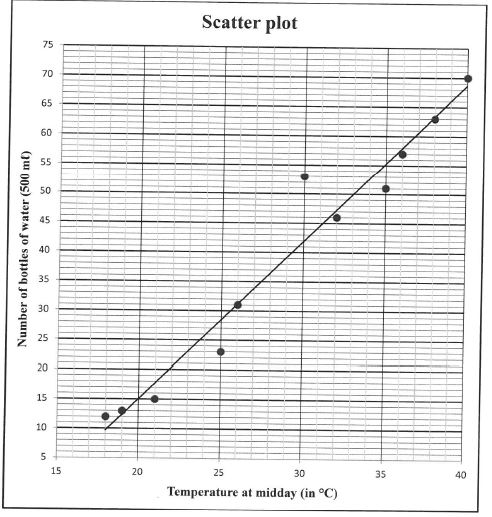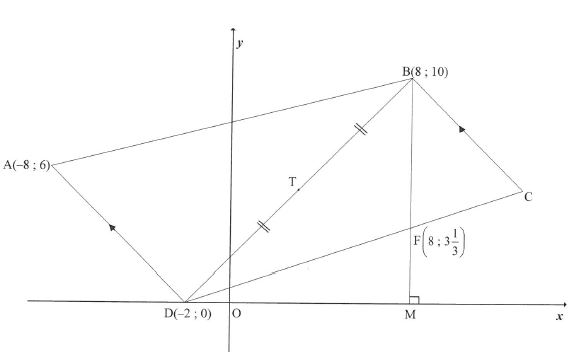Adele
INFORMATION TECHNOLOGY PAPER 2 GRADE 12 QUESTIONS - AMENDED SENIOR CERTIFICATE EXAM PAST PAPERS AND MEMOS MAY/JUNE 2016
INFORMATION TECHNOLOGY
PAPER TWO (P2)
GRADE 12
AMENDED SENIOR CERTIFICATE EXAM
PAST PAPERS AND MEMOS 2016
INSTRUCTIONS AND INFORMATION
- This question paper consists of SIX sections:
SECTION A: Short questions (15)
SECTION B: System Technologies (26)
SECTION C: Communication and Network Technologies (23)
SECTION D: Data and Information Management (27)
SECTION E: Solution Development (22)
SECTION F: Integrated Scenario (37) - Read ALL the questions carefully.
- Answer ALL the questions.
- Start EACH question on a NEW page.
- The mark allocation generally gives an indication of the number of facts/reasons required.
- Number the answers correctly according to the numbering system used in this question paper.
- Write neatly and legibly.
QUESTIONS
SECTION A: SHORT QUESTIONS
QUESTION 1
1.1 Various options are provided as possible answers to the following questions. Choose the answer and write only the letter (A–D) next to the question number (1.1–1.5) in the ANSWER BOOK, FOR EXAMPLE 1.1.6 E.
1.1.1 A file with a .dll extension is …
- used to implement direct links to LAN servers.
- a dynamic link library file.
- used to provide communication to peripheral devices.
- the source code for a database management system. (1)
1.1.2 … is a protocol used to retrieve messages on an Internet/Intranet e-mail server.
- POP3
- HTTPS
- HTTP
- SMTP (1)
1.1.3 A 64-bit processor refers to the …
- processing speed of the processor.
- number of basic instructions the processor can recognise.
- size of the registers inside the processor.
- size of level 1 cache memory inside the processor. (1)
1.1.4 The licence under which most freeware is distributed is known as …
- EULA.
- FTP.
- AUP.
- GNU. (1)
1.1.5 Working away from the company's standard workplace and using the Internet to communicate with the office is known as …
- telecommuting.
- cloud computing.
- piggybacking.
- outsourcing. (1)
1.2 Give the correct computer term for each of the following descriptions. Write only the term next to the question number (1.2.1–1.2.10) in the ANSWER BOOK.
1.2.1 A text file which stores customised settings for a website on your local computer (1)
1.2.2 A technology that automates the configuration process of a device before it can be used (1)
1.2.3 A general term for conning techniques used to make electronic communication appear to originate from a legitimate source (1)
1.2.4 A practice where queries are entered in data fields which then allow unauthorised access to the database (1)
1.2.5 The immediate and real-time delivery of media content to a receiving device over the Internet starting from the time the media file is opened (1)
1.2.6 Simulation of human decision-making processes by a computer system that is programmed to react on the basis of input gained from sensors (1)
1.2.7 A type of search that is managed by humans rather than by reliance on algorithms (1)
1.2.8 The general term for software that allows you to work with electronic databases (1)
1.2.9 A type of website that displays the same information to the user every time it is accessed (1)
1.2.10 Local area network in which resources are shared among workstations without using a dedicated server (1)
TOTAL SECTION A: 15
SECTION B: SYSTEM TECHNOLOGIES
QUESTION 2
A group of IT friends have decided to start a small business. They want to run an Internet café at the local community centre. |
2.1 The friends are considering the use of a notebook computer to run their business.
2.1.1 The notebook that is being considered contains a 2.16 GHz processor with 2 MB cache memory and a 500 GB HDD.
- Briefly explain why the use of cache memory inside a processor enhances the performance of the system. (2)
- Why would it not be possible to upgrade the 2 MB cache memory in the CPU of the notebook? (1)
- Give TWO reasons why a notebook with an SSD would be a better option than one that contains a conventional HDD. (2)
2.1.2 The notebook will be issued with the Windows 10 PRO operating system.
- The management of caching and networking capabilities are some of the functions of an operating system.
Name TWO other primary functions of an operating system. (2) - Besides the Windows operating systems, there is a range of other operating systems.
Briefly state what area of application each of the following operating systems were primarily designed for:- Android (1)
- Unix (1)
- Fast access to the Internet is important for their business.
Explain how web caching is applied to enhance the process of browsing the Internet. (3)
- The management of caching and networking capabilities are some of the functions of an operating system.
2.2 System software consists of operating systems and utility software.
2.2.1 Explain the general purpose of utility software. (1)
2.2.2 Name ONE type of utility software that is used to avoid other windows from appearing on the screen while you are browsing the Internet. (1)
2.2.3 Why is it better to uninstall a program instead of just deleting the program folder? (2)
2.2.4 Files are normally compressed before they are archived.
- Explain the difference between archiving files and backing up files. (2)
- Explain lossy compression. (2)
2.3 Study the diagram below and answer the questions that follow.
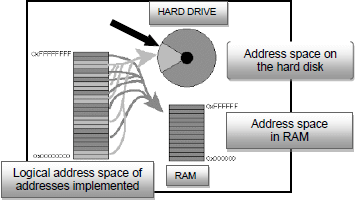
2.3.1 What is the segment on the hard disk, indicated by the black arrow in the diagram above, called? (1)
2.3.2 Explain the concept of the process that is illustrated in the diagram above. (3)
2.4
Although freeware and open-source software are normally provided free of charge, it has been suggested that the learners should rather use open source software. Motivate this suggestion by giving TWO valid arguments. (2)
TOTAL SECTION B: 26
SECTION C: COMMUNICATION AND NETWORK TECHNOLOGIES
QUESTION 3
3.1 Although networking has many advantages in a business environment there may be some challenges from a set-up and management point of view.
Name TWO of these challenges. (2)
3.2 Star topology is a popular choice for the set-up of networks for businesses.
3.2.1 Draw a simple diagram to illustrate a star topology. (3)
3.2.2 State TWO advantages of using a star topology. (2)
3.3 The learners will use UTP cables to set up the computers at the business.
3.3.1 Give ONE advantage of using UTP cables. (1)
3.3.2 Would it be sensible to use fibre-optic cables for the Internet café? State TWO arguments to motivate your answer. (2)
3.4 Data transmission is governed by protocols.
3.4.1 Which protocol is used for a secure website? (1)
3.4.2 What is the function of the VoIP? (1)
3.5 Study the representation of a network below that can be used by a small business. 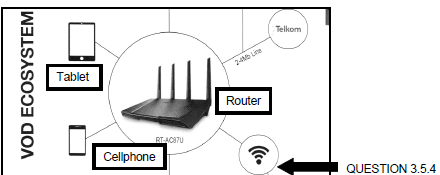
3.5.1 What does VOD stand for? (1)
3.5.2 What is the name given to the physical location in a public area where users may be granted Wi-Fi access to connect wirelessly to the Internet on their mobile devices? (1)
3.5.3 What is the function of an ISP? (1)
3.5.4 What does the symbol indicated by the black arrow in the diagram represent? (1)
3.5.5 Bluetooth technology could be used by a cellphone to share its Internet access.
State ONE disadvantage of using Bluetooth to share access. (1)
3.6 Location-based computing requires the technology to send the location from a device to the computer that is processing it.
3.6.1 Which technology is generally used for location-based computing? (1)
3.6.2 Suggest ONE advantage for the Internet café owners if they use location-based computing. (1)
3.7 The learners will use their mobile devices to send and receive e-mail while they are running their business.
3.7.1 Explain how push technology will keep learners up to date with new e-mails. (2)
3.7.2 State TWO shortcomings when e-mail is received on a mobile device. (2)
TOTAL SECTION C: 23
SECTION D: DATA AND INFORMATION MANAGEMENT
QUESTION 4
The Internet café must keep records of the users and be able to charge users for the time that they were logged onto the Internet. A database for this purpose has been designed for the Internet café.
4.1 The GUI of the software system for the Internet café users is shown below. 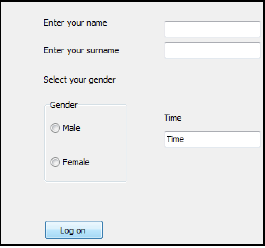
4.1.1 Motivate the choice of radio buttons for the Gender option. (2)
4.1.2 Without changing the label, suggest ONE way in which the GUI could be changed to indicate the format in which the user should enter the time. (1)
4.1.3 The integrity of data is always a problem.
Explain the difference between valid data and correct data by using the information in the GUI above. (2)
4.2 Two tables,tblComputers and tblUsers, have been created for the database.
tblComputers: Keeps data on the computers used at the Internet café. tblUsers: Keeps data on the clients who use the computers at the Internet café.

4.2.1 Indicate how the tables above could be linked so that a one-to-many relationship can be formed. (2)
4.2.2 Write SQL code for the questions below.
- Display the logout time of the users who paid with debit cards in sequential order. (4)
- Change the payment method for 7311017564076 to 'Credit Card'. (3)
- Display the number of users who paid with cash. The number of users must be displayed in a field called CountCashIds. (4)
- Display a list of users who logged in after 12:00 on 2016/02/25. (4)
4.3 An audit trail was set up to maintain the integrity of the database. State the basic information that is captured during an audit trail. (2)
4.4 Large amounts of data, for research and marketing purposes, are collected in a data warehouse.
4.4.1 Some of the data is collected by means of invisible data capturing. Indicate TWO ways in which data is captured invisibly. (2)
4.4.2 Sophisticated software is used to determine significant patterns between the data items statistically.
What is this process called? (1)
TOTAL SECTION D: 27
SECTION E: SOLUTION DEVELOPMENT
QUESTION 5
The group of IT friends are writing customised programs for their business. |
Answer the questions that follow to help them with their problem-solving skills.
5.1 Indicate how many times each of the following loops will be executed:
5.1.1
k ? 1
repeat
… instructions to be executed
until k = 1 (2)
5.1.2
k? 0
while k >= 0
begin
…instructions to be executed
increment k
end (2)
5.2 Each user will log onto the system and an object called User will be instantiated with the following layout:
User | |
Fields | Methods |
-Name:string | +constructor create() |
5.2.1 What does it mean to instantiate an object? (2)
5.2.2 Explain the purpose of:
- An accessor method (1)
- A mutator method (1)
5.2.3
The cost to use an Internet connection is R3,00 per minute. The login and logout time is entered using the 24-hour clock system. For example, the login time is entered as 15:25 and the logout time as 16:05.
Write an algorithm for the CalculateCost(LogoutTime) method in pseudocode to determine the cost for the amount of time that the user was logged onto the Internet. (8)
5.3 For one of the games on the computer the user must enter any integer value between 0 and 100. The computer must generate random numbers until the generated number is the same as the one the user entered. The number of values that were randomly generated must be displayed.
An algorithm to solve this problem is given below.
- Enter number (for example user enters the number 40)
- Found ? false
- While not found do
- randomNum ? Generate a random number in the range 0 to 100
- If randomNum <> number then
- Increment Counter
- Else
- Found ? true
- End of loop
- Display the Counter value
This algorithm contains errors. Copy and complete the trace table to indicate the line numbers where the errors occur. Indicate how the errors may be corrected.
Found | Is Found true? | randomNum | Is randomNum = number? | Counter | Display |
(4)
5.4 Study the pseudocode segment below.
X ? 0
Y ? 1
Loop Z from 0 to 1
Begin
answer ? (X = 1) OR (NOT (Y = 1) OR (Z = 1))
If answer is true then
output ? 1
else
output ? 0
Display X, Y, Z and output
End loop
Write down the values that will be displayed each time the loop is executed. (2)
TOTAL SECTION E: 22
SECTION F: INTEGRATED SCENARIO
QUESTION 6
The IT learners are going to run an Internet café from the local community centre where they have been allocated one room. The venue must be set up to allow the computers to connect in a LAN so that community members can have access to various computer facilities. |
6.1 All hardware in the Internet café will be fitted with an RFID tag.
6.1.1 Which technology do RFID tags use? (1)
6.1.2 Give TWO advantages of having an RFID tag on the hardware. (2)
6.2 One of the learners will be the network administrator.
6.2.1 Motivate the need for a network administrator. (1)
6.2.2 All users will be issued a once-off password which must be changed when they log onto the computer system.
Besides using letters and digits, state TWO other requirements so that passwords will be strong. (2)
6.2.3 The network administrator will need remote access to the server. Name and briefly discuss TWO types of remote access technology. (4)
6.2.4 How can the administrator safeguard the computers against virus attacks? (1)
6.2.5 Besides issuing passwords and avoiding virus attacks, state TWO other responsibilities of the network administrator. (2)
6.3 A helpdesk facility is part of the service provided by the learners. The community members are encouraged to ask questions about computers, ethics and security.
Answer the following questions.
6.3.1 What is spam e-mail? (2)
6.3.2 Suggest TWO ways in which a user may avoid identity theft. (2)
6.3.3 Which technique is used to ensure that Skype calls are secure? (1)
6.3.4 Some websites have a digital certificate. What is the purpose of a digital certificate? (1)
6.3.5 State TWO practical ways in which users can check the validity of the information that they find on the web when they do research. (2)
6.3.6 Explain the concept Internet of Things. (2)
6.3.7 Some people complained that the batteries in their always-on devices were not lasting very long. Give them TWO ideas to improve the battery life of their devices. (2)
6.3.8 Study the information below.
 Explain what a rootkit is. (2)
Explain what a rootkit is. (2)
6.4 Users will be able to download movies at the Internet café. Some users would like to use BitTorrent to download movies.
6.4.1 What type of network is supported by BitTorrent? (1)
6.4.2 One disadvantage of using BitTorrent is the distribution of malware. State ONE other disadvantage of using BitTorrent. (1)
6.5 There are many services, such as Google Drive, which allow users to share data and other services which offer file syncing.
6.5.1 Motivate using a file-sharing service instead of sending a document by e-mail. (2)
6.5.2 List THREE benefits that a file-syncing service offers users. (3)
6.6 The learners want to start a business to develop apps for mobile devices.
State THREE aspects to consider when designing apps for users of mobile devices. (3)
TOTAL SECTION F: 37
GRAND TOTAL: 150
INFORMATION TECHNOLOGY PAPER 1 GRADE 12 QUESTIONS - AMENDED SENIOR CERTIFICATE EXAM PAST PAPERS AND MEMOS 2016
Information Technology
Paper One (P1)
Grade 12
Amended Senior Certificate Exam
Past Papers And Memos 2016
INSTRUCTIONS AND INFORMATION
- This question paper is divided into THREE sections. Candidates must answer ALL THREE sections.
- The duration of this examination is three hours. Because of the nature of this examination it is important to note that you will not be permitted to leave the examination room before the end of the examination session.
- This question paper is set in programming terms that are not specific to any particular programming language (Delphi/Java (using the Netbeans IDE)).
- Make sure that you answer the questions according to the specifications that are given in each question. Marks will be awarded according to the set requirements.
- Answer only what is asked in each question. For example, if the question does not ask for data validation, then no marks will be awarded for data validation.
- Your programs must be coded in such a way that they will work with any data and not just the sample data supplied or any data extracts that appear in the question paper.
- Routines, such as search, sort and selection, must be developed from first principles. You may NOT use the built-in features of a programming language for any of these routines.
- Data structures that are not supplied must be defined by you, the programmer.
- You must save your work regularly on the disk/CD/DVD/flash disk you have been given, or on the disk space allocated to you for this examination session.
- Make sure that your examination number appears as a comment in every program that you code, as well as on every event indicated.
- If required, print the programming code of all the programs/classes that you completed. You will be given half an hour printing time after the examination session.
- At the end of this examination session you must hand in a disk/CD/DVD/flash disk with all your work saved on it OR you must make sure that all your work has been saved on the disk space allocated to you for this examination session. Ensure that all files can be read.
- The files that you need to complete this question paper have been given to you on a disk/CD/DVD/flash disk or on the disk space allocated to you. The files are provided in the form of password-protected executable files.
NOTE:- Delphi candidates must use the file DelphiDataENGJune2016.exe.
- Java candidates must use the file JavaDataENGJune2016.exe.
Do the following: - Double click on the password-protected executable file.
- Click on the 'Extract' button.
- Enter the following password: Hosp9@%$
Once extracted, the following list of files will be available in the folder DelphiDataENGJune2016/JavaDataENGJune2016:
| DELPHI FILES | JAVA (NETBEANS) FILES |
| Question1: Question1_P.dpr Question1_P.res Question1_U.dfm Question1_U.pas | Question1: Question1.form Question1.java |
| Question2: PrescriptionItem.pas Question2_P.dpr Question2_P.res Question2_U.dfm Question2_U.pas | Question2: PrescriptionItem.java Question2.form Question2.java |
| Question3: Question3_P.dpr Question3_P.res Question3_U.dfm Question3_U.pas DataQ3.txt | Question3: |
QUESTIONS
SCENARIO |
SECTION A
QUESTION 1: GENERAL PROGRAMMING SKILLS
| The medical centre has a number of different facilities that are available to the community. |
Do the following:
- Compile and execute the program found in the Question1 folder. The interface displays four different sections named Question1_1 to Question1_4. Currently the program has no functionality.
- Complete the code for each section of QUESTION 1, as described in QUESTION 1.1 to QUESTION 1.4 on the next page.
Example of graphical user interface (GUI):
1.1 Write code to set the font size of the text on the label lblQuestion1_1 to 14 pt and display the text 'Good Health Medical Centre' on the label when the program is executed.
![]() (2)
(2)
1.2 Button [Question1_2]
The community is encouraged to contribute towards a medical aid scheme. The scheme offers four options: Option A to Option D. Option A provides the minimum number of benefits and is the least expensive option with an amount of R1 000,00 per month as contribution for the main member of a family. This amount increases by 20% with each option (Option B, Option C and Option D) thereafter.
Family members of the main member are added as dependants to the account of the main member. An amount of 50% of the payment by the main member will be added to his/her account for each dependant.
The user must select an option from the list box and enter the number of dependants in the text box.
Write code to calculate the total monthly payment the member has to make towards the medical aid scheme. Display the monthly payment in a dialog box with a suitable message. If no option was selected, display a message instructing the user to select an option.
Example of output if Option A is selected and the number of dependants is one: 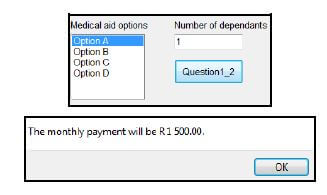
Example of output if Option B is selected and the number of dependants is three (as below):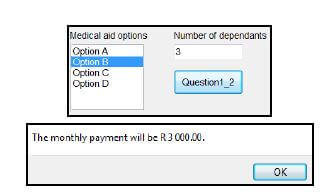
(10)
1.3 Button [Question1_3]
The patient's account can be paid over a period of 12 months.
The first payment is calculated as 15% of the account balance. After the first payment has been deducted the balance must be paid in equal payments over the remainder of the months.
The user is required to enter the account balance in the text box.
Write code to calculate and display the payment number, the amount to be paid monthly and the decreasing balance in neat columns with suitable headings. The amounts must be formatted to currency with two decimal places.
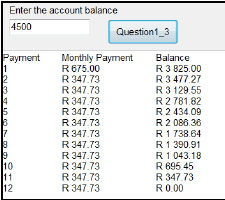
(10)
1.4 There are three doctors on duty every day:
Doctor 1, Doctor 2 and Doctor 3. The total number of patients must be divided equally amongst the three doctors. If there are any remaining patients, the first patient will be allocated to the first doctor (Doctor 1) and the second patient to the second doctor (Doctor 2).
The algorithm below was compiled to calculate and display the number of patients each doctor will attend to during the day.
Algorithm:
- number ? Enter the total number of patients
- patients_per_doctor ? number integer division by 3
- doctor1 ? patients_per_doctor
- doctor2 ? patients_per_doctor
- doctor3 ? patients_per_doctor
- remainder ? number modulus 3
- if remainder = 1 then
doctor1 ? doctor1 + 1
if remainder = 2 then
doctor2 ? doctor2 + 1 - display doctor1, doctor2 and doctor3
1.4.1
- Convert the instructions provided in the algorithm above into programming code to calculate and display the number of patients per doctor. (10)
- The incorrect number of patients is allocated to the doctors due to a logical error in one of the IF statements in the algorithm. Identify the incorrect IF statement and correct it in your code so that the correct number of patients is assigned to each doctor.
Example of correct output for a total of five patients:
Example of correct output for a total of ten patients (as below):
(3)
1.4.2
The doctors on duty have to wait until all the patients on the list have been attended to before they can sign out as a team. They have to provide the number of hours and minutes they have worked using the number of hours and minutes that the first doctor has worked. They are only allowed to sign out on the hour. For example, if they worked for 3 hours and 30 minutes, starting at 08:00, they will all sign out at 12:00.
Add code to the QUESTION1_4 button to do the following:
Obtain the duration of one consultation in minutes. The default time is 15 minutes, but the user is allowed to enter any other value. Obtain the time of day when consulting starts. Calculate and display the time the doctors have worked and the time of day when they will sign out.
Example of output if the total number of patients is five, the duration of one consultation is 15 minutes and consulting starts at 08:00: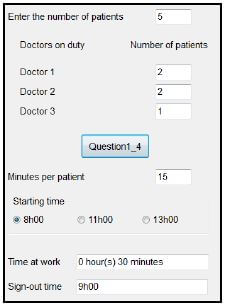
Example of output if the total number of patients is ten, the duration of one consultation is 20 minutes and consulting starts at 13:00: 
(10)
|
TOTAL SECTION A: 45
SECTION B
QUESTION 2: OBJECT-ORIENTATED PROGRAMMING
| The Good Health Pharmacy allows pharmacists to enter the prescription the patient has received for tablets electronically. The labels for the tablet containers and a patient account will then have to be created. The total cost of all prescriptions required must then be calculated. |
Do the following:
| DELPHI PROGRAMMERS | JAVA PROGRAMMERS |
|
|
- Compile and execute the program. The program currently has no functionality. Example of the interface:

NOTE: The pnlGeneric panel is set not to be visible when the program is executed. - Complete the code for this program as specified in QUESTION 2.1 and QUESTION 2.2 below.
2.1
The given incomplete object class (TPrescriptionItem/PrescriptionItem) contains the declaration of four attributes that describes the PrescriptionItem object.
The given attributes of the PrescriptionItem object are as follows:
NAMES OF ATTRIBUTES | DESCRIPTION | |
Delphi | Java | |
fCode | code | A unique six-character code allocated to each prescribed tablet |
fDosage | dosage | A string consisting of four characters to indicate the number of tablets to take (See explanation in note below.) |
fDays | days | The prescribed number of days the tablets must be taken |
fPrice | price | The price of a single tablet |
Complete the code in the given PrescriptionItem class (TPrescriptionItem/PrescriptionItem) as described in QUESTIONS 2.1.1 to 2.1.6 below.
NOTE: The dosage attribute consists of four characters in the format XX#X, where the # is used as a symbol to separate information.
Example 1: D1#B
Example 2: H2#8
First character | Explanation |
D | Tablets must be taken once daily. Second character: Number of tablets to take at a time Fourth character: B: After breakfast S: After supper Example: D1#B means: Take one tablet daily after breakfast. |
H | Tablets must be taken hourly. Second character: Number of tablets to take at a time Fourth character: Refers to the hourly period that the tablet must be taken. The hourly period can either be 2, 3, 4, 6 or 8. Example: H2#8 means: Take two tablets every 8 hours. |
2.1.1 Write code for a constructor method to receive the tablet code, dosage code, number of days and the price per tablet as parameter values. Assign these values to the relevant attributes. (4)
2.1.2 Write a method called calcTabletsPerDay that will use the dosage code to determine and return the number of tablets that is prescribed per day. A day is regarded as a period of 24 hours.
Example 1: If the dosage code is D1#S, it means that one tablet must be taken daily after supper.
Example 2: If the dosage code is H2#4, it means that two tablets must be taken every four hours, which adds up to a total of 12 tablets per day. (8)
2.1.3 Write a method called compileFrequencyOfUseMessage that will use the dosage code to compile and return a message indicating when the tablets should be taken.
Example 1: If the dosage code is D1#S, the message to return is: Take 1 tablet(s) daily after supper.
Example 2: If the dosage code is H4#8, the message to return is: Take 4 tablet(s) every 8 hours. (8)
2.1.4 Write a method called calcTotalTablets to calculate and return the total number of tablets for this prescription item. (3)
2.1.5 Write accessor methods for the tablet code and price attributes. (2)
2.1.6 Write a compileLabel method to return the necessary information to be printed on the label of the tablet container in the format shown below.
Tablet code: <code>
<Frequency of use message> for <number of days> days
(<Total number of tablets included> tablets)
Example of output if the tablet code is HPCMCN, the dosage code is H2#8 and the number of days is four:
| Tablet code: HPCMCN Take 2 tablet(s) every 8 hours for 4 days. (24 tablets) |
(5)
2.2 Two parallel arrays are provided in the incomplete class Question2_U.pas/Question2.java.
The array called arrCodes contains the codes of all available tablets. The array called arrPrices contains the prices per single tablet for each corresponding code.
Example of data in the supplied arrays:
The first four codes in the arrCodes array:
CBLTAD, HPCMCN, TRVKMG, BGJKPT
The first four prices in the arrPrices array:
17.89, 14.60, 23.50, 22.75
The data for the first tablet can be interpreted as follows:
- The code of the tablet is CBLTAD.
- The price of a single tablet is 17.89.
Do the following to complete the code for each button in the main form unit (Delphi)/GUI class (Java):
NOTE: The object objPrescriptionItem has been declared in the program.
2.2.1 Code for the combo box
The user is required to select the code of the tablet from the relevant combo box. If the code selected ends with the letter 'G', it means that a generic equivalent for the tablet is available. The panel pnlGeneric must be displayed, which allows the user to choose the generic equivalent of the tablet. 
A generic tablet is defined as a tablet that is used to treat the same condition as the original tablet but is usually sold at a lower price.
In this program the cost of the generic equivalent of a tablet is 40% less than the cost of the original tablet. The arrPrices array contains the prices of the original tablets.
The pnlGeneric panel must not be visible if there is no generic equivalent available for the tablet.
HINT: The indices of the codes in the arrCodes array are the same as those of the codes in the combo box. (9)
2.2.2 Button [2.2.2 – Instantiate Prescription Item]
Use the information supplied by the user and instantiate a new PrescriptionItem object. The tablet code, dosage code, number of days and the price per tablet must be used as arguments to instantiate the object.
If the pnlGeneric panel appears and the generic check box is selected, the price of the tablet must be reduced by 40% before the object is instantiated.
Display a message in a dialog box to indicate that the object was instantiated successfully.
 (8)
(8)
2.2.3 Button [2.2.3 – Display]
Use the compileLabel method to display the label information in the output area on the Prescription Item panel.
Also display the tablet code and the cost of this prescription item in the output area of the Prescription Account panel. The cost must be formatted to currency with two decimal places.
NOTE: The total cost of all prescription items must be calculated to be displayed when the 2.2.4 – Total of all Prescription Items button is clicked.
Example of output for the prescription item and account details if the tablet code is HPCMCN, the dosage code is D2#B and the number of days entered is 3:

 (8)
(8)
2.2.4 Button [2.2.4 – Total of all Prescription Items]
Display the total amount owed for this specific prescription, formatted to currency with two decimal places.
Example of output for the Prescription Account output area after all prescription items have been entered:
 (2)
(2)
2.2.5 Button [2.2.5 – Clear All]
Clear the output area for the prescription item and the prescription account. Also clear all the input components and set the relevant variables to 0. (3)
|
TOTAL SECTION B: 60
SECTION C
QUESTION 3: PROBLEM-SOLVING PROGRAMMING
SCENARIO |
Do the following:
- Compile and execute the program found in the Question3 folder. Currently the program has no functionality.
- Complete the code for each question as described in QUESTION 3.1 and QUESTION 3.2 below.
Supplied GUI:
The supplied GUI contains components for events that have to take place. An example of the GUI is given below.
Use the program requirements in the questions that follow to decide on a suitable output component to be placed in the output area labelled Ward Statistics on the GUI.
Supplied data:
NOTE: - You are not allowed to modify supplied data manually. Code must be written to manipulate the supplied data according to the requirements.
- The use of good programming techniques and modular design must be applied in the design and coding of your solution.
You are provided with a two-dimensional array called arrWardStats, which contains the number of beds currently occupied by patients in each of the five wards.
The values that appear in the arrWardStats array are the following:
NOTE: The labels are not part of the content of the array.
Ward 1 | Ward 2 | Ward 3 | Ward 4 | Ward 5 | |
Emergency | 10 | 9 | 10 | 8 | 9 |
Children | 9 | 10 | 10 | 9 | 10 |
Adults | 9 | 3 | 8 | 2 | 1 |
3.1 Button [3.1 – Display Ward Statistics]
The program must display the different sections, ward numbers and the number of patients in each ward. The information must be neatly displayed in columns with suitable headings and labels.
Example of output:  (8)
(8)
3.2 Button [3.2 – Place New Patients]
A text file called DataQ3.txt contains information on new patients that need to be admitted. Each line of text in the file contains the full name and date of birth (YYYY-MM-DD) of the patient separated by a hash character. If the patient must be admitted to the emergency ward, a semicolon, followed by the character 'E', has been added to the line of text.
Example of the first three lines of text in the file:
Debra Jenkins#2005-10-12
Geraldine Mathews#1992-01-09
Nosipho Mbele#2010-09-23;E
Write code to do the following:
Check whether the text file DataQ3.txt exists.
If the text file does not exist, display a suitable message and close the program. If the text file exists, do the following for each new patient:
- Determine the section: Emergency, Children or Adults. A patient is considered to be a child if he/she is younger than eighteen years.
- Find a ward with an available bed in the section. The search process must start at Ward 1. If there are no available beds in Ward 1, then Ward 2 must be checked, and so forth. Each ward has a maximum of ten beds.
- Compile a placement code indicating the section and number of the ward where the patient will be placed.
Example:
A3 means that the patient will be placed in the section for adults in Ward 3.
If all wards in the specific section are full, the placement code for the patient must be the words 'Waiting list'.
If an emergency patient is placed on a waiting list, the colour of the 'Emergency' panel must be changed to red.
- Display the name, age and placement code in the output area for new patients.
- If a patient is placed in a ward, the values in the arrWardStats array must be updated accordingly.
Display the updated arrWardStats array after processing all the patients in the text file.
Example of New Patients output area (on the last page):
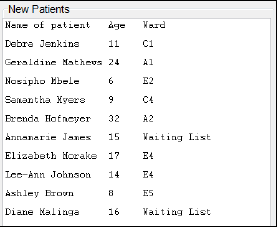
Example of Ward Statistics output area after new patient details have been processed:

MARK ALLOCATION FOR QUESTION 3.2 | |
Read and obtain information from the text file. | 10 |
Determine the section to which the patient will be admitted. | 8 |
Determine the ward that is available in the specific section. | 7 |
Construct the placement code or the words 'Waiting list'. | 6 |
Update the arrWardStats array. | 2 |
Display the name, age and placement code or words of the new patient. | 3 |
Display the updated arrWardStats array. | 1 |
TOTAL | 37 |
|
TOTAL SECTION C: 45
GRAND TOTAL: 150
ENGLISH PAPER 1 GRADE 12 MEMORANDUM - AMENDED SENIOR CERTIFICATE EXAM PAST PAPERS AND MEMOS 2016
English Paper One (P1)
Grade 12
Amended Senior Certificate Exam
Past Papers And Memos 2016
INSTRUCTIONS TO MARKERS
- Candidates are required to answer ALL the questions.
- This memorandum has been finalised at a memorandum discussion session at DBE at which all provinces were represented. Any omissions or queries should be referred to Chief Markers/Analytical Moderators/Internal Moderators at marking centres. All protocol must be followed.
- Candidates' responses should be assessed as objectively as possible.
MARKING THE COMPREHENSION
- Because the focus is on understanding, incorrect spelling and language errors in responses should not be penalised unless such errors change the meaning/understanding. (Errors must still be indicated.)
- If a candidate uses words from a language other than the one being examined, disregard those words, and if the answer still makes sense, do not penalise. However, if a word from another language is used in a text and required in an answer, this will be acceptable.
- For open-ended questions, no marks should be awarded for YES/NO or I AGREE/I DISAGREE. The reason/substantiation/motivation is what should be considered.
- When one word answers are required and the candidate gives a whole sentence, mark correct provided that the correct word is underlined/ highlighted.
- When two/three facts/points are required and a range is given, mark only the first two/three.
- Accept dialectal variations.
- For multiple-choice questions, accept BOTH the letter corresponding with the correct answer AND/OR the answer written out in full.
MEMORANDUM
SECTION A: COMPREHENSION
QUESTION 1
1.1 The youngsters feel positive/hopeful✔ AND cheerful/excited/enthusiastic✔
NOTE: Accept any combination of TWO of the above answers.
Award 1 mark if neither ‘happy’ nor ‘optimistic’ has been changed. (2)
1.2 That it is a way of living where the youth are always✔ engaged with some form of electronic media. ✔
OR
That one can always ✔be reached via cell phone or other gadgets.✔ (2)
1.3 One would not expect✔ the youth to be interested in anything else but cell phones and clothes. ✔
OR
It seems unbelievable that /unlikely that✔ the youth would prioritise family and parents above cell phones and clothes.✔ (2)
1.4 C/third✔ (1)
1.5
- 'Education'
- 'Sport'
- 'Social engagements'
NOTE: Quotations must be accurate. However, do not penalise if quotation marks are omitted. (3)
1.6 Multitasking is when you perform different assignments/tasks/duties at the same time.✔ (1)
1.7
- They do not have positive ways to manage a busy lifestyle.✔
- They develop unhealthy eating habits.✔
- They do not engage (in face-to-face communication) with their families.✔
- They spend too little time with their families.✔
NOTE: Accept any THREE of the above answers. (3)
1.8 Social media relationships/ relationships with people on the internet/ via cell phones✔ have become more important than direct/personal relationships/relationships with people you physically encounter.✔ (2)
1.9 The youth want to be up to date with everything that happens. As a result they are continually engaged with social media. This might be a challenge because they neglect tasks or other social skills and relationships may suffer.
NOTE: The above is merely an example. A candidate can score 1 mark for an answer that is not well-substantiated. For full marks the response must be based on the text. (2)
1.10 The curriculum demands/expectations at schools are greater ✔ than in the past with many assignments and projects having to be completed. ✔ (2)
1.11 youth/teenagers/youngsters
NOTE: Quotations must be accurate. However, do not penalise if quotation marks are omitted. (1)
1.12 The writer tries to tell us to manage our time properly/to slow down the pace✔ to avoid anxiety✔ and start living a meaningful life.✔ (3)
1.13 Trains. ✔ The bar graph indicates that (4.4 %). /They are slow/not safe/reliable/easily accessible ✔
NOTE: The above substantiations are merely examples. Accept other suitable answers. (2)
1.14 There is a picture of a taxi. /The picture of the taxi is big.✔ The column indicating 'Taxi' on the bar graph is the highest.✔ (2)
1.15 Open-ended. Accept a suitable response, e.g.
A bar graph is effective because you can see the different columns showing the main modes of transport clearly. You do not have to read through complicated facts and figures to understand how South Africa gets around.
OR
A bar graph is not effective because some people may not be able to interpret it and would, therefore, prefer a written text.
NOTE: The above are merely examples. A candidate can score 1 mark for an answer that is not well-substantiated. Combination answers are acceptable. (2)
TOTAL SECTION A: 30
SECTION B: SUMMARY
QUESTION 2
The following points form the answer to the question:
QUOTATIONS | FACTS (NOTE: Candidates may phrase the facts differently.) | ||
1. | 'Encourage children to interact with books from a young age.' | 1. | Introduce children to books from an early age. |
2. | 'Take them to the public library and bookstore to teach them the importance of books.' | 2. | Teach children the value of books by taking them to libraries and bookstores. |
3. | 'Make reading an essential part of children's lives/. If you are a working parent, aim to set aside at least fifteen minutes before bedtime to read to your child.' | 3. | Make time to read to your child daily/ regularly. |
4. | 'Read aloud to children until they feel they can do so on their own.'/ '…make the experience imaginative and comical.' | 4. | Read to your children until they are confident enough to be independent readers. / Make reading a positive experience. |
5. | 'Do not give children books that are too difficult to read.' | 5. | Choose books that are easy to read. |
6. | 'When children read on their own, ask them questions about the books they have been reading./ This will make them realise that you are proud of their reading abilities.' | 6. | Show an interest/pride in what children are reading by asking questions about what they have read. |
7. | 'Children who choose their own reading material, regardless of whether it is a novel, a comic book, or a magazine, engage better with what they are reading.' | 7. | Allow and encourage children to select their own material to read. |
8. | Encourage them to read menus, movie names, roadside signs, weather reports and other practical everyday information.' | 8. | Expose children to everyday reading material. |
MARKING THE SUMMARY
The summary should be marked as follows:
- Mark allocation:
- 7 marks for 7 points (1 mark per main point)
- 3 marks for language
- Total marks: 10
- Distribution of language marks when candidate has not quoted verbatim:
- 1–3 points correct: award 1 mark
- 4–5 points correct: award 2 marks
- 6–7 points correct: award 3 marks
- Distribution of language marks when candidate has quoted verbatim:
- 6–7 quotes: award no language mark
- 1–5 quotes: award 1 language mark
NOTE:
- Format: Even if the summary is presented in the incorrect format, it must be assessed.
- Word count:
- Markers are required to verify the number of words used.
- Do not deduct any marks if the candidate fails to indicate the number of words used or if the number of words used is indicated incorrectly.
- If the word limit is exceeded, read up to the last sentence above the stipulated upper limit and ignore the rest of the summary.
TOTAL SECTION B: 10
SECTION C: LANGUAGE
NOTE:
- One-word answers must be marked correct even if the spelling is incorrect, unless the error changes the meaning of the word.
- In full-sentence answers, incorrect spelling should be penalised if the error is in the language structure being tested.
- Sentence structures must be grammatically correct and given in full sentences/as per instructions.
QUESTION 3: ANALYSING AN ADVERTISEMENT
3.1
Anyone who discards used oil into drains/gets rid of used oil in an unsafe manner/ wants to know how to dispose of used oil/ uses motor oil/ (motor) mechanics. (1)
3.2
The advertiser cleverly illustrates how dumping oil can eventually contaminate our drinking water. This is shown through the picture of oil being poured from a gallon into the pipeline ending up in a glass of drinking water.
OR
The font style initially appears dark and resembles water pipes and then becomes lighter resembling drinking water. (2)
3.3
Open-ended. Accept a suitable response, e.g.
This word is effective because it makes the reader realise the dangers of dumping used oil irresponsibly. Therefore, the reader will be influenced to dispose of used oil in a responsible manner.
OR
This word will not be effective if the meaning is not understood by the reader. As a result the message of the advertisement may be lost.
NOTE: The above are merely examples. A candidate can score 1 mark for an answer that is not well-substantiated. Combination answers are acceptable. (2)
3.4 B/acronym✔ (1)
3.5
The South African dialling code / 021✔
The website address which has the South African country code 'za' at the end. /www.rosefoundation.org.za.✔ (2)
3.6 Don't (1)
3.7 Company (1)
[10]
QUESTION 4: ANALYSING A CARTOON
4.1
Indoors/ in the living room/lounge/sitting room/home. ✔
There is a lamp in the room. /Calvin's father is sitting in an armchair.✔ (2)
4.2
He wants to ask his father something/get his attention/ wants to win his favour/wants to create an atmosphere of trust/ secrecy /confidentiality/ reassurance. (1)
4.3
Frame 3: The ellipsis indicates a pause between words/hesitation/suspicion of the father.
Frame 4: The ellipsis indicates that Calvin has not completed his sentence/ has been interrupted.
NOTE: If the frame is not mentioned, the sequence must be correct. (2)
4.4
4.4.1 Verbal clues: The use of very bold font for 'DO'. / The exclamation mark (and the question mark side by side.)/ The words are all in bold font and 'DO' is in a darker font.
Visual clues: The jagged speech bubble (to show anger)/ the large bold font to show that he is shouting/ his mouth wide open to show that he is shouting/his arms are outstretched /his head is tilted back to show tension and frustration.
NOTE: Accept THREE of the above answers that discuss both verbal and visual techniques. (3)
4.4.2Open-ended. Accept a suitable response, e.g.
The father is justified. He knows his son's behaviour✔ and expects that Calvin has done something seriously wrong. ✔
OR
The father is not justified in his reaction because Calvin has not yet told him what he has done✔/he jumps to conclusions. ✔
NOTE: The above are merely examples. A candidate can score 1 mark for an answer that is not well-substantiated. (2)
[10]
QUESTION 5: LANGUAGE AND EDITING SKILLS
NOTE: Spelling in this question must be correct.
5.1
5.1.1
- received/ receives (1)
- farmer's (1)
- them (1)
- at/on (1)
5.1.2 Brackets✔and dashes✔ (2)
5.1.3 pronoun✔
adjective✔ (2)
5.1.4 The mechanic gave the Land Rover her first professional makeover.✔ (1)
5.1.5 Pieter told the mechanic that he✔ had been✔ looking for him✔ the whole day.
NOTE: Award ONE mark for each underlined change and ONE mark for the correct use of punctuation. (4)
5.1.6 D/personification (1)
5.2
5.2.1 The entire country knew when the Springboks were playing. (2)
5.2.2 divides/fragments/splits/separates (1)
5.2.3
Accept a suitable response e.g.
He has a sore throat.
She saw him at the rugby match.
He went to the hardware shop to buy a saw.
NOTE: The homophone must be used correctly in the sentence. (1)
5.2.4 Watching the Springboks at the stadium is better than watching them on television. (1)
5.2.5 don't they/do they not (1)
[20]
TOTAL SECTION C: 40
GRAND TOTAL: 80
ENGLISH PAPER 3 GRADE 12 MEMORANDUM - AMENDED SENIOR CERTIFICATE EXAM PAST PAPERS AND MEMOS 2016
English Paper Three (P3)
Grade 12
Amended Senior Certificate Exam
Past Papers And Memos 2016
INSTRUCTIONS AND INFORMATION
This memorandum must be used together with the attached English FAL assessment rubrics for SECTIONS A, B and C.
MEMORANDUM
SECTION A: ESSAY
QUESTION1
Instructions to Markers:
- Candidates are required to write on ONE topic only.
- The ideas listed below the topics are only some ways in which the topic could be interpreted.
- Full credit must be given for the candidates' own interpretation.
- Marking must be objective. Give credit for relevant ideas.
- Use the 50-mark assessment rubric to mark the essays. The texts produced by candidates must be assessed according to the following criteria as set out in the assessment rubric:
- Content and planning (30 marks)
- Language, style and editing (15 marks)
- Structure (5 marks)
NOTE: No additional penalties may be imposed as the rubric itself imposes penalties.
1.1 My entire future lay in that sealed envelope.
Narrative/Reflective/Descriptive
- If narrative, the essay must have a strong story line. The essay must have an interesting ending.
- If reflective, the essay should convey emotional reactions and feelings experienced by the writer.
- If descriptive, the writer should create a picture in words, trying to use as many senses as possible to make the description clear. [50]
1.2 Write an essay that includes the following words:
We could not stand each other when we met but now ...
NOTE: The words given in the topic MUST be included somewhere in the essay.
Narrative/Reflective/Descriptive
- If narrative, the essay must have a strong story line. This topic lends itself to the possibility of being written in both the past and the present tense. The essay must have an interesting ending.
- If reflective, the essay should convey emotional reactions and feelings experienced by the writer.
- If descriptive, the writer should create a picture in words, trying to use as many senses as possible to make the description clear. [50]
1.3 How I reached my most difficult goals.
Reflective/Descriptive/Narrative
- If reflective, the essay should convey emotional reactions and feelings experienced by the writer.
- If descriptive, the writer should create a picture in words, trying to use as many senses as possible to make the description clear.
- If narrative, the essay must have a strong story line, usually written in the past tense. The essay must have an interesting ending. [50]
1.4 It was picture perfect.
Descriptive/Reflective/ Narrative
- If descriptive, the writer should create a picture in words, trying to use as many senses as possible to make the description clear.
- If reflective, the essay should convey emotional reactions and feelings experienced by the writer.
- If narrative, the essay must have a strong story line, usually written in the past tense. The essay must have an interesting ending. [50]
1.5 Problems can arise if one generation fails to understand the other.
Argumentative/Reflective/Discursive
- If argumentative, the essay must reflect a specific argument or viewpoint for or against the topic. The candidate should give a range of arguments to support and substantiate his/her view. The conclusion should be a strong, clear and convincing statement of the writer's opinion.
- If reflective, the writer must still take a stance for or against the topic. • If discursive, the writer may come to a particular conclusion at the end of the essay but the arguments for and against must be well-balanced and clearly analysed in the course of the essay.[50]
1.6 What you wear reflects who you are.
Discursive/Argumentative
- The writer may come to a particular conclusion at the end of the essay but the arguments for and against must be well-balanced and clearly analysed in the course of the essay.
- If argumentative, the essay must reflect a specific argument or viewpoint for or against the topic. The candidate should give a range of arguments to support and substantiate his/her view. The conclusion should be a strong, clear and convincing statement of the writer's opinion. [50]
1.7 Interpretation of pictures
- The candidate may interpret the pictures in any way.
- The candidate may choose to write any type of essay.
- The interpretation must be linked to the picture.
- The candidate should give the essay a suitable title.
- The candidate may write in any appropriate tense.
1.7.1 Picture: A girl reading a book
- Literal interpretations: importance of reading, literacy, children's education.
- Figurative interpretations: liberation, hope, escaping into a world of your own.
1.7.2 Picture: Roads
- Literal interpretations: road construction, scenery, road transport, how development impacts on nature.
- Figurative interpretations: career choices, making difficult decisions, road less travelled. [50]
TOTAL SECTION A: 50
SECTION B: LONGER TRANSACTIONAL TEXT
QUESTION 2
Instructions to Markers:
- Candidates are required to answer ONE question.
- Marking must be objective. Give credit for relevant ideas.
- Use the 30-mark assessment rubric to mark the responses in this section. The texts produced by candidates must be assessed according to the following criteria as set out in the assessment rubric:
- Content, planning and format (18 marks)
- Language, style and editing (12 marks)
NOTE: No additional penalties may be imposed as the rubric itself imposes penalties.
2.1 FORMAL LETTER
A letter of complaint
- The following aspects of format should be included:
- Address of sender
- Date
- Recipient: The Manager
- Name of the store
- Address of recipient
- Greeting/Salutation
- Topic line
- Suitable ending
- Signature and name of sender
- The tone and register of the letter should be formal.
- The candidate must give details of the complaint.
- The expectations of the writer must be clear. [30]
2.2 OBITUARY
A close colleague has passed away suddenly.
- The tone must be formal.
- The following aspects of format should be included:
- Full name of the deceased
- Date of birth
- Date of death
- The following information may also be included:
- Birthplace
- Where the person was living at the time of death
- Key survivors (spouse, children) and their names
- Date and time of funeral
- Biographical information
- A tribute must be paid to the deceased. [30]
2.3 REVIEW
Film/DVD review
- The tone and register should be appropriate for the target audience.
- The content must be suitable for family viewing.
- The following information should be included in the review, among others: o The title of the film/DVD
- A description of plot, main characters and key incidents
- A judgment or evaluation/rating of the film/DVD
- Some of the following may be included:
- Genre/setting/plot/style/lighting/camera angles
- Director/producer of the film/DVD
- Accept different formats of the review. [30]
2.4 SPEECH
Speech at a wedding
- The speechshould be written using a suitable salutation/greeting.
- The tone and register should be appropriate for the audience.
- The speech must include the following:
- Purpose
- Audience
- The introduction must attract attention.
- Points must be developed well.
- A conclusion must be included. [30]
TOTAL SECTION B: 30
SECTION C: SHORTER TRANSACTIONAL TEXT
QUESTION 3
Instructions to Markers:
- Candidates are required to answer ONE question.
- Marking must be objective. Give credit for relevant ideas.
- Use the 20-mark assessment rubric to mark the responses in this section. The texts produced by candidates must be assessed according to the following criteria as set out in the attached rubric:
- Content, planning and format (12 marks)
- Language, style and editing (8 marks)
NOTE: No additional penalties may be imposed as any deviations are addressed bythe rubric.
3.1 ADVERTISEMENT
Seeking employment
- The advertisement should:
- Have a catchy headline to attract the attention of the reader
- Have the following details: qualifications, experience and contact details
- Create interest and desire in the service
- Inspire action
- The target market should be clear.
- The language may be formal or informal but not slang or colloquial.
NOTE: Do not award marks for illustrations. [20]
3.2 DIARY ENTRIES
The candidate's feelings before and after a discussion with the friend.
- There MUST be TWO diary entries with two different dates.
- The entries should express the candidate's feelings before and after the discussion with the friend.
- The diary entries should be written in the first person.
- The language should be simple and informal.
- The tone must reflect suitable emotions. [20]
3.3 INSTRUCTIONS
Appropriate behaviour in a library
- The instructions may be in point or paragraph form.
- The candidate must mention the context of the library in the heading. • Instructions must be in a logical sequence.
- The instructions should say how one has to behave appropriately in a library. [20]
TOTAL SECTION C: 20
GRAND TOTAL: 100
SECTION A: ASSESSMENT RUBRIC FOR ESSAY – FIRST ADDITIONAL LANGUAGE [50 MARKS]
Criteria | Exceptional | Skilful | Moderate | Elementary | Inadequate | |
CONTENT & PLANNING (Response and ideas) Organisation of ideas for planning; Awareness of purpose, audience and context 30 MARKS | UPPER LEVEL | 28–30 | 22–24 | 16–18 | 10–12 | 4–6 |
|
|
|
|
| ||
LOWER LEVEL | 25–27 | 19–21 | 13–15 | 7–9 | 0–3 | |
|
|
|
|
| ||
LANGUAGE, STYLE & EDITING Tone, register, style, vocabulary appropriate to purpose/effect and context; Word choice; Language use and conventions, punctuation, grammar, spelling 15 MARKS | UPPER LEVEL | 14–15 | 11–12 | 8–9 | 5–6 | 0–3 |
|
|
|
|
| ||
LOWER LEVEL | 13 | 10 | 7 | 4 | ||
|
|
|
| |||
STRUCTURE Features of text; Paragraph development and sentence construction 5 MARKS | 5 | 4 | 3 | 2 | 0–1 | |
|
|
|
|
| ||
MARK RANGE | 43–50 | 33–40 | 23–30 | 13–20 | 0–10 |
SECTION B: ASSESSMENT RUBRIC FOR LONGER TRANSACTIONAL TEXT – FIRST ADDITIONAL LANGUAGE [30 MARKS]
Criteria | Exceptional | Skilful | Moderate | Elementary | Inadequate |
CONTENT, PLANNING & FORMAT Response and ideas; Organisation of ideas for planning; Purpose, audience, features/conventions and context 18 MARKS | 15–18 | 11–14 | 8–10 | 5–7 | 0–4 |
|
|
|
|
| |
LANGUAGE, STYLE & EDITING Tone, register, style, purpose/effect, audience and context; Language use and conventions; Word choice; Punctuation and spelling 12 MARKS | 10–12 | 8–9 | 6–7 | 4–5 | 0–3 |
|
|
|
|
| |
MARK RANGE | 25–30 | 19–23 | 14–17 | 9–12 | 0–7 |
SECTION C: ASSESSMENT RUBRIC FOR SHORTER TRANSACTIONAL TEXT – FIRST ADDITIONAL LANGUAGE [20 MARKS]
Criteria | Exceptional | Skilful | Moderate | Elementary | Inadequate |
CONTENT, PLANNING & FORMAT Response and ideas; Organisation of ideas; Features/conventions and context 12 MARKS | 10–12 | 8–9 | 6–7 | 4–5 | 0–3 |
|
|
|
|
| |
LANGUAGE, STYLE & EDITING Tone, register, style, vocabulary appropriate to purpose and context; Language use and conventions; Word choice; Punctuation and spelling 8 MARKS | 7–8 | 5–6 | 4 | 3 | 0–2 |
|
|
|
|
| |
MARK RANGE | 17–20 | 13–15 | 10–11 | 7–8 | 0–5 |
ENGLISH PAPER 2 GRADE 12 MEMORANDUM - AMENDED SENIOR CERTIFICATE EXAM PAST PAPERS AND MEMOS 2016
English Paper Two (P2)
Grade 12
Amended Senior Certificate Exam
Past Papers and Memos 2016
INSTRUCTIONS AND INFORMATION
- Candidates are required to answer questions from TWO sections.
- A candidate may not answer more than ONE question on the same genre.
- If a candidate gives two answers where the first one is wrong and the next one is correct, mark the first answer and ignore the rest.
- If answers are incorrectly numbered, mark according to the memo.
- If a spelling error affects the meaning, mark incorrect. If it does not affect the meaning, mark correct.
- If a candidate does not use inverted commas when asked to quote, do not penalise.
- For open-ended questions, no marks should be awarded for YES/NO or I AGREE/I DISAGREE. The reason/substantiation/motivation is what should be considered.
- No marks should be awarded for TRUE/FALSE or FACT/OPINION. The reason/substantiation/motivation is what should be considered.
- Candidates' responses should be assessed as objectively as possible.
MEMORANDUM
SECTION A: NOVEL
QUESTION 1: TO KILL A MOCKINGBIRD
Candidates are required to answer BOTH questions, i.e. QUESTIONS 1.1 and 1.2.
1.1
1.1.1
- E/brother of the narrator✓
- C/narrator of the novel✓
- D/cousin of the narrator✓
- B/father of the narrator✓ (4)
1.1.2 Cecil announces (in the school yard) that Scout's father defends niggers✓and Scout becomes very angry.✓/She wants to punch/hit/fight him.✓ (2)
1.1.3
- She is strict/a good disciplinarian to the children. ✓
- She is fair. ✓
- She is not a racist/prejudiced. ✓
- She is not afraid to speak her mind. ✓
- She is caring. ✓
- She is loving towards the children/motherly. ✓
NOTE: Accept any TWO of the above. (2)
1.1.4 Maycomb is plagued by racism and so Tom, being a black man,✓will be found guilty irrespective of his innocence. ✓
OR
Atticus is a respected white lawyer✓ who will lose the respect of the white Maycomb society if he chooses to defend Tom. ✓ (2)
1.1.5 'She says they're clean-living folks.' ✓ (1)
1.1.6
- Courage/Compassion/Moral values. ✓
- Atticus tries to teach his children (Scout and Jem) not to judge people. He teaches Scout to have compassion/ to treat people equally. These are some of the values he tries to instil in his own children therefore he must defend Tom Robinson – it affects him personally. ✓✓
OR - Racial prejudice. ✓
- Atticus is advised not to take the case because Tom will be found guilty because of the colour of his skin. ✓✓
NOTE: 1 mark for identification + 2 marks for discussion.
Accept other valid interpretations for the discussion.
The discussion must be relevant to the initial theme. (3)
1.1.7 Open-ended
Accept a text-based response which shows that the candidate knows and understands the following aspects, among others:
- Atticus's bravery;
- his good moral values;
- the fact that he leads by example;
- *how Atticus proves that the colour of one's skin does not
- determine whether one is less of a man/human;
- the fact that Atticus puts his children's lives at risk and they are almost killed;
- his actions can be regarded as irresponsible.
NOTE: Do NOT award a mark for YES or NO.
Credit responses where a combination is given.
For full marks, the response must be well-substantiated.
A candidate can score 1 or 2 or 3 marks for a response which is not well-substantiated. The candidate's interpretation must be grounded in the text of the novel. (4)
1.2
1.2.1
- C/Bob Ewell✓ (1)
- Atticus proves that Bob attacks his own daughter (Mayella) and then tries to blame Tom Robinson. ✓
Bob swears to take revenge on Atticus. ✓ (2) - Scout is almost choked/smothered/flung to the ground ✓ and Jem's arm is broken. ✓ (2)
- He is heartless/cruel/abusive/evil. ✓
- He is vengeful. ✓
- He is dishonest. ✓
- He is a neglectful father. ✓
NOTE: Accept any TWO of the above. (2)
1.2.2
- Simile ✓ (1)
- It shows how tightly Bob holds Scout /Bob's strength. ✓ (1)
1.2.3
- Boo (Radley) ✓ kills Bob (Ewell)/the attacker/their attacker. ✓ (2)
- He means no harm. ✓/He is kind/caring. ✓
- He is not the monster he is made out to be. ✓
- He is protective of the children. ✓
- He is brave/courageous. ✓
NOTE: Accept any TWO of the above. (2)
1.2.4 Open-ended
Accept a text-based response which shows that the candidate knows and understands the following aspects, among others:
- People believe Tom is guilty even before the case starts – this is a result of the racial prejudice in Maycomb;
- The social prejudice in the Maycomb society causes Tom to be secluded with the result that nobody knows his gentle nature;
- The community finds it hard to believe that a black man can do something good.
NOTE: For full marks, the response must be well-substantiated.
A candidate can score 1 or 2 or 3 marks for a response which is not well-substantiated.
The candidate's interpretation must be grounded in the text of the novel. (4)
[35]
QUESTION 2: LORD OF THE FLIES
Candidates are required to answer BOTH questions, i.e. QUESTIONS 2.1 and 2.2.
2.1
2.1.1
- E/symbolises all that is good ✓
- D/a quiet but evil boy ✓
- B/undisciplined and fun-loving ✓
- C/believes in democracy ✓ (4)
2.1.2
- Jack has taken all the boys away to hunt✓
AND
therefore there is no fire/smoke to attract the attention of the ship that passes. ✓ (2) - Yes. This was an opportunity for them to be rescued. ✓
OR
No. They needed meat/food, so the hunt was necessary. ✓ (1)
- Jack has taken all the boys away to hunt✓
2.1.3 'We had a smashing time.' ✓ (1)
2.1.4
- Jack disobeys Ralph's instruction to keep the fire going. ✓
- He takes all the boys on the hunt. ✓
- He does not see the importance of the fire/ignores Ralph's concern in his excitement about the hunt. ✓
NOTE: Accept any TWO of the above. (2)
2.1.5
- Savagery/Innate evil. ✓
- The boys have just killed a pig./They are very proud of their actions./They are becoming bloodthirsty./They look savage./They have painted faces./Jack removes his clothing. ✓✓
OR - Loss of innocence/Triumph of evil. ✓
- The boys have killed a pig./They have taken a life./They are losing the link to civilization./They are proud of their actions./Rescue does not seem to be important. ✓✓
NOTE: 1 mark for identification + 2 marks for discussion.
Accept other valid interpretations for the discussion.
The discussion must be relevant to the initial theme. (3)
2.1.6 Open-ended
Accept a text-based response which shows that the candidate knows and understands the following aspects, among others:
- Jack is a good disciplinarian;
- he provides food for the boys;
- the hunt creates the element of fun which he deems important to keep the boys happy;
- he was in a leadership position before - he was head boy of the choir;
- he is a dictator and rules by instilling fear;
- he is not concerned about rescue and does things to suit himself;
- he manipulates the boys.
NOTE: For full marks, the response must be well-substantiated.
A candidate can score 1 or 2 or 3 marks for a response which is not well-substantiated. The candidate's interpretation must be grounded in the text of the novel. (4)
2.2
2.2.1 Jack and his tribe attack Ralph's camp and steal Piggy's glasses. ✓ (1)
2.2.2
- Piggy is fed up with Jack bullying him/He is no longer prepared to tolerate Jack's behaviour.✓
- Piggy is angry and wants to confront Jack. ✓
- Piggy overestimates Jack's ability to be reasonable. ✓
NOTE: Accept any TWO of the above. (2)
2.2.3 (a) Simile ✓ (1)
(b) To emphasise Piggy's weak sight without his glasses. ✓/To show Piggy's near-blindness without his spectacles. ✓/Piggy is vulnerable without his glasses. ✓ (1)
2.2.4 (a) Simon is killed by the boys who are dancing and chanting ✓and the boy with the birthmark dies in the fire. ✓ (2)
(b) They have become savage/bloodthirsty/primitive/uncivilised. ✓ They are now able to kill each other/humans. ✓ (2) \
2.2.5
- Ralph is protective./He is afraid Piggy might get hurt. ✓ He is caring./He does not want Piggy to get hurt. ✓
- He is realistic./He knows Jack is stronger than Piggy. ✓
- He is rational./He knows what the consequences of Piggy's actions might be. ✓
NOTE: Accept any THREE of the above. (3)
2.2.6 C/anger ✓ (1)
2.2.7 Piggy is killed by Roger/a rock dislodged from Castle Rock. ✓ (1)
2.2.8 Open-ended
Accept a text-based response which shows that the candidate knows and understands the following aspects, among others:
- The innate evil of the boys on the island;
- the boys' ability to be both good and bad (Simon and Ralph (good) and Roger and Jack (bad);
- without rules the boys become corruptible;
- the boys become capable of murder/savagery;
- the boys are no better than animals because they kill each other;
- when Jack hunts Ralph down, survival of the fittest reigns supreme.
NOTE: For full marks, the response must be well-substantiated. A candidate can score 1 or 2 or 3 marks for a response which is not well-substantiated. The candidate's interpretation must be grounded in the text of the novel. (4)
[35]
QUESTION 3: A GRAIN OF WHEAT
Candidates are required to answer BOTH questions, i.e. QUESTIONS 3.1 and 3.2.
3.1
3.1.1
- D/works at the library ✓
- C/a detention camp ✓
- A/the research station ✓
- E/Margery's husband ✓ (4)
3.1.2 He says he had sex with her. ✓ (1)
3.1.3 C/mocking. ✓ (1)
3.1.4
- Thompson wants to send Karanja to his house/to Margery/his wife. ✓
- He wants Karanja to inform his wife that he will not be home for lunch. ✓ (2)
3.1.5
- Mwaura is suspected of betraying Karanja./He is in the employ of General R. ✓
- Karanja is suspected of betraying Kihika. ✓
- Mwaura does not trust Karanja./Karanja is regarded as a traitor to the people of Kenya./He betrayed the people of Kenya by working for the British Government. ✓
NOTE: Accept any TWO of the above. (2)
3.1.6 Karanja is easily angered. ✓
He is rude. ✓
He is impatient. ✓ (3)
3.1.7 Open-ended
Accept a text-based response which shows that the candidate knows and understands the following aspects, among others:
- The symbolic significance of the title: in order for wheat to grow it first has to die.
- Kenya's struggle for independence can be linked to the symbolic significance of the title.
- the loss of life/sacrifice is a necessary element for independence to be gained.
NOTE: For full marks, the response must be well-substantiated. A candidate can score 1 or 2 or 3 marks for a response which is not well-substantiated. The candidate's interpretation must be grounded in the text of the novel. (4)
3.2
3.2.1 He has told Mugo about Mumbi's unfaithfulness. ✓ (1)
3.2.2
'Suddenly he wanted to go, get away from Mugo, and cry his shame in the dark.' ✓
OR
'Gikonyo felt the discomfort of a man standing before a puritan priest.' ✓ (1)
3.2.3 A puritan/priest is somebody who is pure ✓ but Mugo is actually guilty of betraying Kihika. ✓ (2)
3.2.4
- Metaphor ✓ (1)
- It shows/highlights that Gikonyo feels suffocated/weighed down/depressed/frustrated ✓ by his problems (darkness) because of Mumbi's betrayal/the broken relationship between him and Mumbi. ✓ (2)
3.2.5
- To gain his freedom ✓ to be with Mumbi. ✓ (2)
- He felt that he had betrayed the movement for nothing as Mumbi had betrayed him. ✓ (1)
- Sadness/anger/disappointment ✓ (1)
3.2.6 Betrayal. ✓
Mumbi betrays Gikonyo by having intercourse with Karanja. She also has an illegitimate child. Gikonyo feels that he has betrayed the Movement. ✓✓
OR
Shame. ✓
Gikonyo is ashamed for telling Mugo about Mumbi's betrayal/behaviour. He is ashamed for baring his soul to Mugo. Gikonyo feels that he has betrayed the Movement. ✓✓
NOTE: 1 mark for identification + 2 marks for discussion.
Accept other valid interpretations for the discussion.
The discussion must be relevant to the initial theme. (3)
3.2.7 Open-ended
Accept a text-based response which shows that the candidate knows and understands the following aspects, among others:
- Their circumstances at the time: because of the war they are separated;
- Gikonyo is detained for a long period of time;
- Mumbi suffers greatly and is vulnerable;
- Karanja takes advantage of Mumbi's vulnerability;
- Mumbi should not have succumbed to his advances;
- Gikonyo should have been more understanding of her circumstances;
- their circumstances are no excuse for their behaviour.
NOTE: For full marks, the response must be well-substantiated. A candidate can score 1 or 2 or 3 marks for a response which is not well-substantiated. The candidate's interpretation must be grounded in the text of the novel. (4)
[35]
TOTAL SECTION A: 35
SECTION B: DRAMA
QUESTION 4: ROMEO AND JULIET
Candidates are required to answer BOTH questions, i.e. QUESTIONS 4.1 and 4.2.
4.1
4.1.1
- B/cousin ✓
- D/husband ✓
- A/father ✓
- C/confidante ✓ (4)
4.1.2 The two families are enemies/foes/adversaries/have a long standing feud. ✓ (1)
4.1.3
- D/challenge✓ (1)
- The beautiful Rosaline will seem ugly✓ when compared to the other girls at the ball.✓/Compared to the other girls at the ball Romeo will realise that Rosaline is not beautiful✓ but in fact ugly. ✓ (2)
4.1.4
- He is impulsive. ✓
- Romeo is irrational. ✓
- He is immature. ✓
- He loves to exaggerate. ✓
- He is stubborn. ✓
NOTE: Accept any TWO of the above. (2)
4.1.5
- Love/Love versus hate. ✓
Romeo meets Juliet and is stunned by her beauty.
He instantly falls in love with her.
He completely forgets about his feelings for Rosaline.
The love between Romeo and Juliet blooms despite the hate between the Capulets and the Montagues. ✓✓✓
OR - Fate. ✓
He only realises later that he is in love with a Capulet.
He marries Juliet in secret.
Their union leads to tragic consequences for them. ✓✓✓
NOTE: 1 mark for identification + 3 marks for discussion.
Accept other valid interpretations for the discussion.
The discussion must be relevant to the initial theme. (4)
- Love/Love versus hate. ✓
4.1.6 Open-ended
Accept a text-based response which shows that the candidate knows and understands the following aspects, among others:
- The fact that Benvolio prevents fighting, whereas Tybalt is confrontational;
- that Benvolio tries to reason, whereas Tybalt wants to settle arguments by fighting;
- Benvolio is calm/relaxed, whereas Tybalt is provocative.
NOTE: For full marks, the response must be well-substantiated.
A candidate can score 1 or 2 marks for a response which is not well-substantiated. The candidate's interpretation must be grounded in the text of the drama. (3)
4.2
4.2.1
- Nonchalant/indifferent/unconcerned/casual✓
- Tybalt is the enemy/not important to Mercutio. ✓ (2)
4.2.2 Benvolio encourages them to settle their differences in private as he knows Prince (Escalus) has forbidden any public fighting. ✓/Prince (Escalus) will have them killed. (1)
4.2.3 Mercutio is quick-tempered/feisty. ✓/He is confrontational/ challenging. ✓/He is mocking. ✓
Benvolio is calm/resolute. ✓/He is sensible /reasonable. ✓/He is peace-loving. ✓
NOTE: Accept any TWO of the above for each of the characters.
The comparison must be clear for full marks. (4)
4.2.4
- Angry/defiant/adamant/determined/challenging/arrogant. ✓ (1)
- Open-ended
Accept a text-based response which shows that the candidate knows and understands the following aspects, among others:
- that he responds to an insult by Tybalt;
- the fact that he challenges Tybalt to a fight;
- that their fighting could have fatal consequences;
- Prince Escalus has ordered that there may not be any fights in public.
NOTE: Do NOT award a mark for YES or NO.
The candidate's interpretation must be grounded in the text of the drama. (1)
4.2.5
- Tybalt wants to fight Romeo, Mercutio intervenes and is killed.✓
Romeo becomes angry and avenges Mercutio's death and kills Tybalt. ✓
The Prince arrives and Romeo is banished. ✓ (3) - Juliet mourns the death of her cousin/Tybalt because her husband Romeo has killed him. ✓
She is separated from her husband/Romeo which directly leads to both their deaths. ✓ (2)
- Tybalt wants to fight Romeo, Mercutio intervenes and is killed.✓
4.2.6 Open-ended
Accept a text-based response which shows that the candidate knows and understands the following aspects, among others:
- Because the love between Romeo and Juliet leads to a secret marriage, it has no influence on the behaviour of others;
- honesty instead of secrecy could have resulted in acceptance;
- out of fear for Capulet and loyalty, the Nurse keeps Juliet's secret;
- the Friar marries them in secret, instead of trying to mediate a peaceful end to the feud;
- Fate plays a role when Romeo is not informed of the plan with the potion.
NOTE: For full marks, the response must be well-substantiated. A candidate can score 1, 2 or 3 marks for a response which is not well-substantiated. The candidate's interpretation must be grounded in the text of the drama. (4)
[35]
QUESTION 5: NOTHING BUT THE TRUTH
Candidates are required to answer BOTH questions, i.e. QUESTIONS 5.1 and 5.2.
5.1
5.1.1
a) C/nephew✓
b) D/wife✓
c) B/brother✓
d) A/daughter✓ (4)
5.1.2 She is a teacher. ✓ (1)
5.1.3
- Both Thando and Mandisa attach value to their African heritage/are proud to be African. ✓When Mandisa tells Thando that Themba called her 'African Princess', Thando says that Sipho called her the same. ✓
- They are both intellectually/mentally strong/well-educated/ independent thinkers.✓ They have a lively debate on the workings of the TRC and neither is afraid to voice her opinions./It is clear that both girls have a thorough grounding in the history of the Struggle. ✓
- Both girls respect tradition. ✓ Even though the African custom of staying home to mourn is strange to Mandisa, she agrees to respect it when informed by Thando. ✓ Both girls regard family as important. ✓ Thando immediately treats Mandisa like a sister (she even calls her 'sister').Mandisa not only agrees to change her arrangements and stay with Thando and Sipho, but she is also clearly delighted to learn more of her African family. ✓
- Both girls are hardworking/ ambitious.✓ Thando holds two jobs and Mandisa comes to the funeral but will also see a fashion designer on work related issues. ✓ (4)
NOTE: Accept any TWO of the above combinations as well as other relevant and correct examples from the text.
5.1.4 He does not have faith/believe in the TRC/does not want to relive the sorrow/horror that is revealed at the TRC/is more concerned about the restructuring at the library than the events at the TRC. ✓ (1)
5.1.5 ('My father always said that) he was the best in the whole country.' ✓
NOTE: Do not penalise if quotation marks are omitted. (1)
5.1.6
- Truth/Reconciliation/Forgiveness/Justice. ✓
At the amnesty hearings the perpetrator reveals the truth.
Depending on the nature of the crime they are granted amnesty.
Some perpetrators of apartheid crimes were sentenced to lengthy prison terms.
Some victims/families received retribution for crimes committed against them during apartheid. ✓✓✓
NOTE: 1 mark for identification + 3 marks for discussion.
Accept other valid interpretations or the discussion.
The discussion must be relevant to the initial theme. (4)
- Truth/Reconciliation/Forgiveness/Justice. ✓
5.1.7 Open-ended
Accept a text-based response which shows that the candidate knows and understands the following aspects, among others:
- Mandisa grew up in a different country/England and lacks full knowledge of South Africa/TRC;
- her lack of understanding of the concept of reconciliation and forgiveness;
- she believes there should be punishment for crimes;
- she has a lack of knowledge of the apartheid era.
NOTE: For full marks, the response must be well-substantiated.
A candidate can score 1 or 2 marks for a response which is not well-substantiated. The candidate's interpretation must be grounded in the text of the drama. (3)
5.2
5.2.1 Port Elizabeth✓ (1)
5.2.2 B/figuratively ✓ (1)
5.2.3 Anger/fury/shock/disbelief/outrage. ✓ (1)
5.2.4
- Pride/admiration/satisfaction/gratitude ✓
Due to her father's achievements/good work in the library.✓
OR
Anger/bitterness/resentment✓
Sipho did not get the job. ✓ (2) - Admiration/respect/appreciation/ ✓
She believes in Sipho since she recommends him for the position as Chief Librarian. ✓/She is concerned about him when he is not appointed as Chief Librarian. ✓/She appreciates him when she acknowledges that he is valuable to the running of the library. ✓
NOTE: Accept any other relevant examples. (2)
- Pride/admiration/satisfaction/gratitude ✓
5.2.5 Thando consoles her father.✓/She empathises with him.✓/She feels sorry for him. ✓
Mandisa is angry./She is furious./ She is disgusted.✓/ Mandisa incites him to take action. ✓
NOTE: Accept any TWO of the above for each of the characters. The comparison must be clear for full marks. (4)
5.2.6
Sipho is caring because he keeps warm water when Thando comes from work. ✓
He is sometimes very strict when he tells her she cannot go to Johannesburg with her cousin. ✓
Thando respects her father when she obeys his orders. ✓
Thando is a dutiful daughter as she does not want to leave the house before she prepares dinner. ✓
They observe similar traditional values as both adhere to the mourning period. ✓
NOTE: Accept any TWO of the above. (2)
5.2.7 Open-ended
Accept a text-based response which shows that the candidate knows and understands the following aspects, among others:
- Themba could have mended his relationship with Sipho;
- he could have apologised for the affair;
- he could have sought forgiveness from Sipho;
- Themba felt ashamed for having an affair with Sipho's wife;
- his return might have caused Sipho more pain/harm;
- he made a new life for himself in London.
NOTE: Do NOT award a mark for YES or NO.
Credit responses where a combination is given.
For full marks, the response must be well-substantiated.
A candidate can score 1, 2 or 3 marks for a response which is not well-substantiated. The candidate's interpretation must be grounded in the text of the drama. (4)
[35]
TOTAL SECTION B: 35
SECTION C: SHORT STORIES
QUESTION 6
Candidates are required to answer BOTH Questions i.e. QUESTIONS 6.1 AND 6.2
6.1 'The Sisters'
6.1.1 Marrying old Jan Redlinghuis./humilation ✓ (1)
6.1.2 B/see her mother in heaven ✓ (1)
6.1.3
- Jan is insensitive when he drives Marta around in the streets of Platkops✓/He is boastful when he tells everybody that Burgert sold Marta to him. ✓/Jan is unreasonable by requesting Marta in return for land. ✓
- Marta is sensitive to her father's plight when she agrees to marry Jan. ✓/She is loyal to her father when she decides to save him financially. ✓/Marta is obedient when she allows Jan to humiliate her. ✓/She is loving/kind when she never judges anyone/ Jan. ✓
NOTE: Accept any ONE of the above for each character. The comparison must be clear for full marks. Accept any other relevant, correct examples. (2)
6.1.4
- Zeekoegatt ✓and Bitterwater. ✓ (2)
- Only Burgert is happy with the state of his lands. ✓
Sukey realises that Marta is suffering/is being humiliated./
Sukey knows that the water-cases caused her mother's death. ✓
NOTE: Award one mark for each character. (2) - Burgert is materialistic /obsessed /greedy/selfish✓ (1)
6.1.5\
Powerlessness of women/Women being exploited/abused. ✓ Marta and Sukey are powerless in this situation. They have no control over what is happening to them.
Marta is the victim of her father's greed. ✓✓✓
OR
Family betrayal/Obsession/Greed/Selfishness.✓ Sukey feels betrayed by her father. She blames her father for Marta's humiliation. It is his greed that causes the humiliation.✓✓✓
NOTE: 1 mark for identification + 3 marks for discussion.
Accept other valid interpretations for the discussion.
The discussion must be relevant to the initial theme. (4)
6.1.6 Open-ended
Accept a text-based response which shows that the candidate knows and understands the following aspects, among others:
- Marta is brought up to be obedient;
- she is too good/gentle to resist Jan;
- she believes that it is part of the sacrifice she is making for her father;
- she should never have agreed to marry Jan;
- she should have stood up for herself and refused to be driven around in public;
- she should have remembered her mother's fate;
- Marta knew full well what Jan Redlinghuis was like;
NOTE: Do NOT award a mark for YES or NO.
Credit responses where a combination is given.
For full marks, the response must be well-substantiated.
A candidate can score 1,2 or 3 marks for a response which is not well-substantiated. The candidate's interpretation must be grounded in the text of the short story. (4)
QUESTION 6.2
6.2 'The Soft Voice of the Serpent'
6.2.1
- The garden (of the young couple). ✓ (1)
- The young man is convalescing/recovering/trying to heal physically ✓ and emotionally ✓ from the loss of his leg.
OR
The young man has lost a leg✓ therefore the peaceful and beautiful garden makes it ideal for the man's healing process. ✓ (2)
6.2.2
- Simile ✓ (1)
- He is harmless because he is in a wheelchair and cannot move ✓ just like the locust which has also lost its (left) leg. ✓
OR
The man and the locust share a similar condition. ✓ (2) -
- He is loving/gentle towards her. ✓
- He cares for her. ✓
- He is protective of her. ✓
NOTE: Accept any TWO of the above. (2)
6.2.3
- She is disgusted/in disbelief that she injured the locust. ✓
- She feels guilty for hurting the locust. ✓
- She regrets her actions. ✓
NOTE: Accept any TWO of the above. (2)
6.2.4
- The man is angry at the world because of the loss of his leg/he is confined to the wheelchair. ✓
- He struggles to accept his handicap.✓
- He is sometimes impatient with his wife when he answers her curtly. ✓
- He becomes irritated with his wife when she pities the locust. ✓
- The woman is not angry at the world/is more positive because she always acts in a pleasant manner. ✓
- The woman has come to accept her husband's disability when she treats him with great respect.✓
- She is empathetic towards her husband. ✓
- She is patient/tolerant of his mood swings when she does not react to his outbursts. ✓
NOTE:
Accept any TWO of the above for each character.
The comparison must be clear for full marks.
Accept any other relevant, correct examples (4)
6.2.5 Open-ended.
Accept a text-based response which shows that the candidate knows and understands the following aspects, among others:
- The garden of the couple is similar to the Garden of Eden;
- there is no real serpent in this garden;
- the locust is symbolic of the serpent/ the betrayal of a serpent;
- the locust (serpent) changes the relationship between the man and the woman;
- the man's peace is shattered with the arrival of the locust;
- the young man feels betrayed when the locust can still fly after its injury.
NOTE: For full marks, the response must be well-substantiated. A candidate can score 1, 2 or 3 marks for a response which is not well-substantiated. The candidate's interpretation must be grounded in the text of the short story. (4)
TOTAL SECTION C: [35]
SECTION D: POETRY
NOTE: Candidates are required to answer ALL the questions.
7.1 'The serf'
7.1.1
- Italian/Petrarchan sonnet/ Irregular sonnet ✓ (1)
- The first eight lines are known as the octave. ✓
The last six lines are known as the sestet. ✓
OR
In this sonnet half of line 9 forms part of the octave ✓and the other half belongs to the sestet. /The turning point is in the middle of line 9 and not in the beginning.✓ (2)
7.1.2
- 'torrid' ✓ (1)
- It is so hot that he does not want/need to wear a shirt/ clothes. ✓/He works very slowly/sleepwalks. ✓ (1)
- D/a cloud of dust✓ (1)
- 'slow somnambulist'✓ (1)
- The serf works mechanically as if he is asleep. ✓
He is not enthusiastic. ✓/ He seems to find the work boring. ✓ (2)
7.1.3 His heart is empty and hurt, ✓ just as the land is left bruised/hurt after ploughing. ✓ (2)
7.1.4 The serf will physically destroy the symbols of oppression ✓and be freed from forced labour. ✓ (2)
7.1.5 Threatening/ominous/foreboding/rebellious. ✓ (1)
7.1.6 Open-ended
Accept a text-based response which shows that the candidate knows and understands the following aspects, among others:
- The difficult working circumstances of the serf;
- that he has been enslaved/has lost his land and has to work for somebody else;
- the fact that he has lost his individuality/identity as a proud warrior;
- he has suffered severely at the hands of his oppressors;
- given the opportunity, the labourer will conquer his masters;
- that the serf will destroy the symbols of power and wealth.
NOTE: Do not award a mark for PITIED or FEARED
Credit responses where a combination is given.
For full marks, the response must be well-substantiated.
A candidate can score 1 or 2 marks for a response which is not well-substantiated. The candidate's interpretation must be grounded in the text of the poem. (3)
7.2 'An elementary school classroom in a slum'
7.2.1
- To emphasise how great the distance is between the slum where the children are✓ and the sea and rivers which would offer them a different life experience. ✓ (2)
-
- There is a tall girl. ✓
- She has a big head.✓
- There is a very thin boy. ✓
- The boy's eyes are red.✓
- There is a disabled/disfigured boy.✓
- There is a boy who looks like he is dreaming.✓
- The children are pale.✓
- The children's hair is untidy/unkempt. ✓
NOTE: Accept any THREE of the above. (3)
- He escapes in his imagination. ✓ (1)
7.2.2
(a) The children's world is the classroom and the streets they live in, ✓not the world map on the wall. ✓ (2)
(b) Metaphor✓ (1)
(c) Open-ended
Accept a response which shows knowledge and understanding of, among others:
- The fact that the pictures can be an escape mechanism;
- that these pictures can be inspirational;
- the fact that education is the key to escape poverty;
- that the pictures make them realise that there is a better world out there.
NOTE: Do NOT award a mark for YES or NO.
Credit responses where a combination is given.
For full marks, the response must be well substantiated. A candidate can score 1, 2 or 3 marks for a response which is not well-substantiated. The candidate's interpretation must be grounded in the text of the poem. (4)
7.2.3 Their living experience is darkened by their living conditions in the slums, ✓meaning they do not have any hope for a bright future. ✓ (2)
7.2.4 Hope for the future. ✓
He pleads/appeals to all officials to get involved to improve/make better the lives/future of these children. ✓✓
NOTE: 1 mark for identification + 2 marks for discussion.
Accept other valid interpretations for the discussion.
The discussion must be relevant to the initial theme. (3)
TOTAL SECTION D: 35
GRAND TOTAL: 70
ENGLISH PAPER 3 GRADE 12 QUESTIONS - AMENDED SENIOR CERTIFICATE EXAM PAST PAPERS AND MEMOS 2016
English Paper Three (P3)
Grade 12
Amended Senior Certificate Exam
Past Papers And Memos 2016
INSTRUCTIONS AND INFORMATION
- This question paper consists of THREE SECTIONS:
SECTION A: Essay (50)
SECTION B: Longer Transactional Text (30)
SECTION C: Shorter Transactional Text (20) - Answer ONE question from EACH section.
- Write in the language in which you are being assessed.
- Start EACH section on a NEW page.
- You must plan (e.g. using a mind map/diagram/flow chart/key words), edit and proofread your work. The plan must appear BEFORE each text.
- All planning must be clearly indicated as such. It is advisable to draw a line through all planning.
- You are strongly advised to spend approximately:
- 80 minutes on SECTION A
- 40 minutes on SECTION B
- 30 minutes on SECTION C.
- Number the answers correctly according to the numbering system used in this question paper.
- Write down the title/heading of each response. Give your own title/heading if one has not been provided.
- The title/heading must NOT be included when doing a word count.
- Write neatly and legibly.
QUESTIONS
SECTION A: ESSAY
QUESTION 1
- Write an essay of between 250 and 300 words in length on ONE of the following topics.
- Write down the NUMBER and TITLE of the essay correctly, for example 1.1 My entire future lay in that sealed envelope.
- Give your own title if your choice is QUESTION 1.2, 1.7.1 OR 1.7.2.
- Spend approximately 80 minutes on this section.
1.1 My entire future lay in that sealed envelope. [50]
1.2 Write an essay that includes the following words:
We could not stand each other when we met, but now ... [50]
1.3 How I reached my most difficult goals. [50]
1.4 It was picture perfect. [50]
1.5 Problems can arise if one generation fails to understand the other. [50]
1.6 What you wear reflects who you are. [50]
1.7 Choose ONE of the pictures and write an essay on a topic that comes to mind. Write the question number (1.7.1 or 1.7.2) and give your essay a suitable title.
NOTE: There must be a clear link between your essay and the picture you have chosen.
1.7.1 [50] 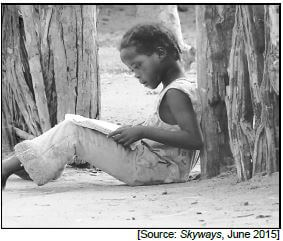
1.7.2 [50] 
SECTION B: LONGER TRANSACTIONAL TEXT
QUESTION 2
- Respond to ONE of the following transactional writing tasks.
- The body of your response should be between 120 and 150 words in length.
- Write down the NUMBER and the HEADING of the text you have chosen, for example 2.1 FORMAL LETTER.
- Pay particular attention to format, language and register.
- Spend approximately 40 minutes on this section.
2.1 FORMAL LETTER
You have been experiencing problems with your cell phone which you recently purchased.
Write a letter of complaint to the manager of the store from which you bought the cell phone. [30]
2.2 OBITUARY
A close colleague has passed away suddenly. His or her family has asked you to write an obituary paying tribute to him or her. [30]
2.3 REVIEW
You are the owner of a store that hires out films/DVDs. You provide reviews of films to assist your customers in their selection.
Write a review of a recently released film/DVD that is suitable for family viewing. [30]
2.4 SPEECH
Your best friend will be getting married soon and you have been invited to speak at the wedding.
Write out the speech that you will deliver at the wedding. [30]
TOTAL SECTION B: 30
SECTION C: SHORTER TRANSACTIONAL TEXT
QUESTION 3
- Choose ONE of the following topics and write a short text.
- The body of your response should be between 80 and 100 words in length.
- Write down the NUMBER and the HEADING of the text you have chosen, for example, 3.1 ADVERTISEMENT.
- Spend approximately 30 minutes on this section.
3.1 ADVERTISEMENT
You have just completed your studies and have decided to place an advertisement in a local newspaper to seek employment. Write out the content of your advertisement.
NOTE: Do NOT include illustrations or drawings. [20]
3.2 DIARY ENTRIES
Your close friend has left you feeling disappointed about something. You have decided to discuss the matter with him or her.
Write out TWO diary entries expressing your feelings before and after your discussion with your friend. [20]
3.3 INSTRUCTIONS
You are a volunteer at your local library. The librarian has reported that some learners do not behave well when visiting the library. He or she has asked you to write out a set of instructions on how to behave when using the library.
Write out the instructions. [20]
TOTAL SECTION C: 20
GRAND TOTAL: 100
ENGLISH PAPER 1 GRADE 12 QUESTIONS - AMENDED SENIOR CERTIFICATE EXAM PAST PAPERS AND MEMOS 2016
English Paper One (P1)
Grade 12
Amended Senior Certificate Exam
Past Papers And Memos 2016
INSTRUCTIONS AND INFORMATION
- This question paper consists of THREE sections:
SECTION A: Comprehension (30)
SECTION B: Summary (10)
SECTION C: Language (40) - Answer ALL the questions.
- Read ALL the instructions carefully.
- Start EACH section on a NEW page.
- Leave a line between answers.
- Number the answers correctly according to the numbering system used in this question paper.
- For multiple-choice questions, write only the question number and the letter (A–D) of the correct answer.
- Pay special attention to spelling and sentence construction.
- Use the following time frames as a guideline:
SECTION A: 50 minutes
SECTION B: 30 minutes
SECTION C: 40 minutes - Write neatly and legibly.
QUESTIONS
SECTION A: COMPREHENSION
QUESTION 1
Read BOTH TEXT A and TEXT B and answer the set questions.
TEXT A
HURRY UP AND 'BE'
|
NOTE:
- Answer ALL the questions in your OWN WORDS.
- For one-word answers, write only the question number and the word. • For multiple-choice questions, write only the question number and the letter (A–D) of the correct answer.
1.1 How do South African youngsters feel about the future? (2)
1.2 Explain what the writer means when he refers to teenagers' way of life as 'continuously connected' (lines 3–4). (2)
1.3 Refer to paragraph 2.
Why is it surprising that cellphones and clothes have dropped out of the top three in the Sunday Times Generation Next Youth Brand Survey of 2015? (2)
1.4 Choose the correct answer to complete the following sentence.
In the Sunday Times Generation Next Youth Brand Survey of 2015, music was ranked ...
- first.
- second.
- third.
- fourth. (1)
1.5 Quote THREE pressures that the youth experience, according to Janet Davel. (3)
1.6 What does it mean to multitask (line 12)? (1)
1.7 How do parents who spend too much time working set a poor example for their children? State THREE ways. (3)
1.8 Anastasia Savopoulos says that more emphasis is placed on electronic relationships than on real ones. What does she mean by this? (2)
1.9 Discuss how the fear of missing out (paragraph 8) may become a negative factor in today's technological world. (2)
1.10 Why do today's school-going youth face much higher workloads than the previous generations? (2)
1.11 Find a word from the passage that means the same as 'adolescents' (line 52). (1)
1.12 Explain Janet Davel's intention or goal in the concluding paragraph. (3)
TEXT B 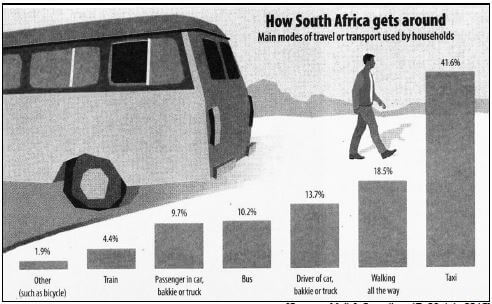
1.13 What is the SECOND least popular mode of transport used by South Africans? Give a reason for your answer. (2) [Source: Mail & Guardian, 17–23 July 2015]
1.14 How do the graphics show that the taxi is the most popular mode of transport? (2)
1.15 The artist used a bar graph to show how South Africans travel. Discuss the effectiveness of conveying information in this way. (2)
TOTAL SECTION A: 30
SECTION B: SUMMARY
QUESTION 2
You have been asked to write an article on what parents can do to encourage children to read. The article will be placed in an educational newspaper.
Read TEXT C below and list SEVEN points that you will include in your article on how to encourage children to read.
INSTRUCTIONS
- Your summary must be written in point form.
- List your SEVEN points in full sentences, using no more than 70 words.
- Number your sentences from 1 to 7.
- Write only ONE point per sentence.
- Use your OWN words as far as possible.
- Indicate the total number of words you have used in brackets at the end of your summary.
TEXT C
ENCOURAGING CHILDREN TO READ Teaching children to love reading involves a lot more than simply handing them a book. |
TOTAL SECTION B: 10
SECTION C: LANGUAGE
QUESTION 3: ANALYSING AN ADVERTISEMENT
Study the advertisement (TEXT D) below and answer the set questions.
TEXT D 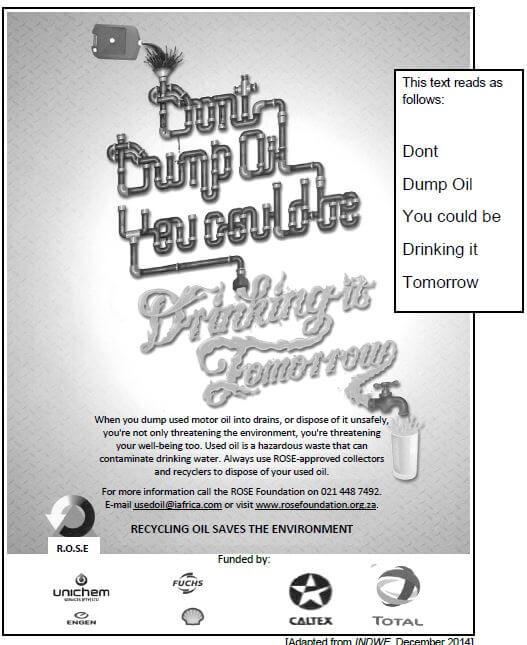
3.1 Whose attention does the advertiser hope to attract in this advertisement? (1)
3.2 Refer only to the visual aspects of TEXT D.
Discuss ONE advertising technique that is used to capture the reader's attention. (2)
3.3 Refer to the body copy of the advertisement.
Discuss whether the use of the word 'hazardous' is effective in the advertisement. (2)
3.4 The advertisement is for the R.O.S.E. Foundation, whose logo appears on the left side.
Choose the correct answer to complete the following sentence:
R.O.S.E. is an example of a …
- homonym.
- acronym.
- synonym.
- pseudonym. (1)
3.5 Which TWO clues in the contact details prove that the R.O.S.E. Foundation operates in South Africa? (2)
3.6 The contraction 'Dont' in the text is incorrect.
Rewrite the word, inserting an apostrophe in the correct place. (1)
3.7 Give the singular form of the underlined word in the following sentence. Write down only the correct word.
There are many oil companies that support the responsible disposal of oil. (1)
[10]
QUESTION 4: ANALYSING A CARTOON
Read the cartoon (TEXT E) below and answer the set questions.
TEXT E
Calvin and Hobbes by Bill Watterson 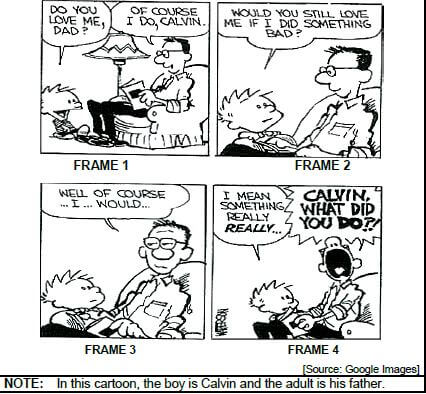
4.1 Refer to FRAME 1.
Where does the conversation between Calvin and his father take place? Give a reason for your answer. (2)
4.2 Give a reason why Calvin moves closer to his father in FRAMES 2 and 3. (1)
4.3 Ellipsis (…) is used differently in FRAMES 3 and 4.
Explain these TWO different uses of ellipsis. (2)
4.4 Refer to FRAME 4.
4.4.1 Which verbal and visual clues does the cartoonist use to show that Calvin's father is upset? (3)
4.4.2 Discuss whether Calvin's father is justified in being upset. (2)
[10]
QUESTION 5: LANGUAGE AND EDITING SKILLS
5.1 Read the passage (TEXT F) below, which has some deliberate errors, and answer the set questions.
TEXT F
AN OLD LAND ROVER SCORES A MAKEOVER In a case of mistaken identity, an old Land Rover recieves its first ever professional makeover from a dreamy mechanic. Elsa Jansen explains how it happened.
|
5.1.1 Correct the SINGLE error in each of the following sentences. Write down ONLY the question numbers and the words you have corrected.
- In a case of mistaken identity, an old Land Rover recieved its first ever professional makeover from a dreamy mechanic. (1)
- A farmers workhorse is a wonderful vehicle. (1)
- When a vehicle on his farm gives him problems, he phones the professionals and lets they worry about it. (1)
- The following week the mechanic arrived by our farm and began repairing our old Land Rover. (1)
5.1.2 Name TWO punctuation marks that can be used to replace the commas in the following sentence:
Our neighbour Pieter, a pharmacist, does not waste time with engines. (2)
5.1.3 Identify the parts of speech of the underlined words.
She is often driven in harsh conditions. (2)
5.1.4 Rewrite the following sentence in the active voice:
The Land Rover was given her first professional makeover by the mechanic. (1)
5.1.5 Change the following sentence into reported speech:
Pieter told the mechanic, 'I was looking for you the whole day.'
Start with:
Pieter told the mechanic that ... (4)
5.1.6 Choose the correct answer to complete the following sentence:
The figure of speech used to describe the writer's Land Rover in the first nine lines of the passage is …
- a metaphor.
- a simile.
- assonance.
- personification. (1)
5.2 Study the text (TEXT G) below and answer the set questions.
TEXT G 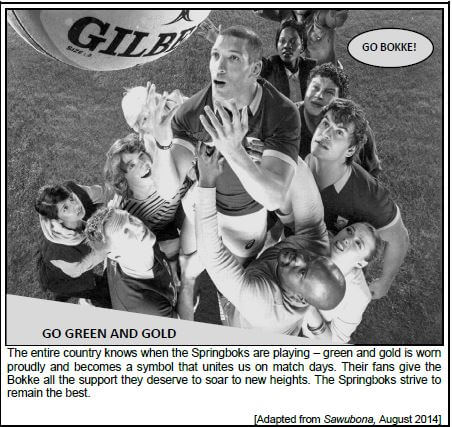
5.2.1 Rewrite the following sentence in the past tense:
The entire country knows when the Springboks are playing. (2)
5.2.2 Give the antonym of the word 'unites' in the following sentence:
The entire country knows when the Springboks are playing – green and gold is worn proudly and becomes a symbol that unites us on match days. (1)
5.2.3 Study the following sentence and use a homophone for the word 'soar' in a sentence of your own.
Their fans give the Bokke all the support they deserve to soar to new heights. (1)
5.2.4 Rewrite the following sentence and give the correct form of the word in brackets:
Watching the Springboks at the stadium is (good) than watching them on television. (1)
5.2.5 Complete the following tag question.
The Springboks strive to remain the best, ...? (1)
[20]
TOTAL SECTION C: 40
GRAND TOTAL: 80
GRADE 12 MATHEMATICS PAPER 2 MEMORANDUM - SENIOR CERTIFICATE EXAMINATIONS PAST PAPER (MEMORANDUM) 2016
Mathematics Paper 2
Grade 12
Senior Certificate Examinations
Past Paper (memorandum) 2016
NOTE:
- If a candidate answered a question TWICE, mark only the FIRST attempt.
- If a candidate has crossed out an attempt to answer a question and did not redo it, mark the crossed-out version.
- Consistent accuracy applies in ALL aspects of the marking memorandum. Stop marking at the second calculation error
- Assuming answers/values in order to solve a problem is NOT acceptable.
MEMORANDUM
QUESTION 1
| 8 | 8 | 10 | 12 | 16 | 19 | 20 | 21 | 24 | 25 | 26 |
| 1.1 | Mean = 189/11
| ✓189 | |
| 1.2 | Min = 8, max = 26 | ✓ min, max | |
| 1.3 |  | ✓ box | |
| 1.4 | The data is skewed to the left OR Negatively skewed | ✓ answer (1) | |
| 1.5 | SD/SA = 6,46 | ✓✓ answer (2) | |
| 1.6 | 17,18 + 6,46 = 23,64 | ✓ interval |
QUESTION 2
| Temperature at midday (in °C) | 18 | 21 | 19 | 26 | 32 | 35 | 36 | 40 | 38 | 30 | 25 |
| Number of bottles of water (500 mℓ) | 12 | 15 | 13 | 31 | 46 | 51 | 57 | 70 | 63 | 53 | 23 |
| 2.1 | (30 ; 53) | ✓answer (1) |
| 2.2 | a = – 38,51 b = 2,68 ∴ yˆ = 2,68x – 38,51 | ✓ value a ✓ value b ✓ equation (3) |
| 2.3 | ∴ yˆ ≈ 36,53 bottles OR | ✓✓ answer (2) ✓substitution |
| 2.4 | Strong The majority of the points lie close to the regression line. OR Strong | ✓ strong ✓strong/sterk |
| 2.5 | Temperature cannot rise beyond a certain point as this would be life threatening OR there is only so much water one can consume before it becomes a risk to your health (hyponatremia)./ | ✓ reason(1) [9] |
QUESTION 3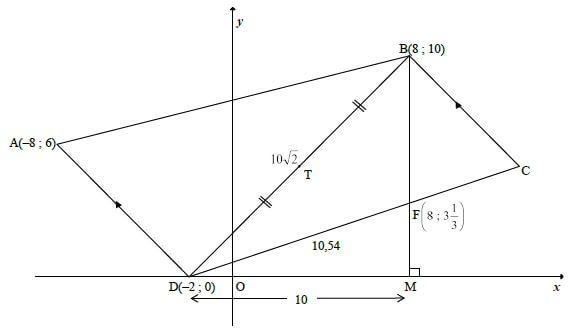
| 3.1 | mAD = y2 - y1 x2 - x1 = 0 - 6 -2 +8 = -6 = -1 6 | ✓substitution ✓–1 (2) |
| 3.2 | mBC = -1 [BC | | AD] mBC = -1 [BC | | AD] | ✓ gradient ✓substitute m and (8 ; 10) ✓ equation (3) |
| 3.3 | mBD = y2 - y1 OR AD2 = 72 or AD = √72 or 6√2 | ✓substitution ✓ answer ✓ ⋅ mBD × mAD = 1 × -1 = -1 (3) ✓✓ calculating all 3 sides ✓ AB2 = AD2 + BD2 (3) |
| 3.4 | tan BDM = MBD = 1
| ✓ tan BDM = MBD ✓sin BDM = 1 |
| 3.5 | T (x ; y) =[ x1 + x2 ; y1 + y2] OR mDF = 31/3 - 0 = 1 | ✓T(3 ; 5) ✓eq of DF ✓value of x ✓ value of y (3) |
| 3.6 | area ΔBDF = area ΔBDM - area ΔDFM OR area ΔBDF = ½. BF.DM OR tan FDM =mDC = 5 - 0 = 1 or tan FDM = FM = 10/3 = 1 OR BF = 20/3 or 62/3 OR area Δ BDF OR tan FDM =mDC = 5 - 0 = 1 or tan FDM = FM = 10/3 = 1 | ✓ formula/method ✓ formula/method ✓ gradient/ratio
✓ BF ✓ formula/method ✓ gradient/ratio |
QUESTION 4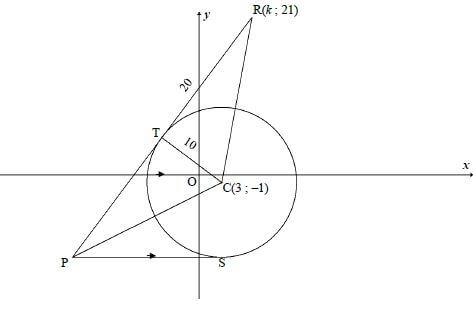
| 4.1 | radius ⊥ tangent | ✓ R (1) |
| 4.2 | CR² = TR² + CT² (Pyth) | ✓ substitution ✓ answer (2) |
| 4.3 | CR² = (X2 - X1)² + (Y2 -Y1)² OR CR² = (X2 - X1)² + (Y2 -Y1)² | ✓ substitution
|
| 4.4 | (x - 3)² + (y + 1)² = 100 | ✓✓ answer (2) |
| 4.5 | CS = 10 and CS ⊥ PS ∴S(3; −11) | ✓S(3; −11) |
| 4.6.1 | S(3;-11) OR 4/3x + 35/3 = -11 | ✓ substituting ✓ answer (2) ✓ equating
|
| 4.6.1 | PT = PS [tangents from common point] OR
OR
| ✓ S ✓R ✓ value of PC ✓ value of PC |
| 4.7.1 | M(3;−16) | ✓answer (1) |
| 4.7.2 | Radius = 4 | ✓ answer (1) |
| 4.7.3 | r1 + r2 = 10 +4 = 14 distance CM = = √225 = 15 CM > r1 + r2 Therefore the two circles do not intersect or touch | ✓r1 + r2 ✓ 15 |
QUESTION 5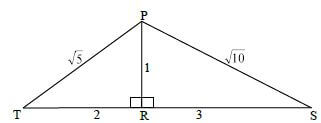
| 5.1.1(a) | sin T = 1/√5 = √5/5 = 0,45 | ✓value (1) |
| 5.1.1(b) | cos S = 3/√10 = 3√10/10 = 0,95 | ✓value (1) |
| 5.1.2 | cos (T + S) = cosTcosS - sinTsinS = 6/√50 - 1/√50 = 5/√50 or 1/√2 or √2/2 | ✓expansion ✓ simplification |
| 5.2 | 1 - tan2(180º + θ) cos(360º - θ)sin(90º - θ) = 1 - tan2 θ (cos θ)(cos θ) = 1 - (sin2 θ) (cos2 θ) (cos2 θ) = 1 - sin2 θ cos2 θ = cos2 θ or 1 - sin2 θ cos2 θ 1 - sin2 θ | ✓cosθ ✓tan2 θ ✓sin2 θ ✓ answer (6) |
| 5.3 | (sin x - cos x)2 = [3/4]2 sin²x - 2sinxcosx + cos²x = 9/16 1 - 2sinxcosx = 9/16 2sinxcosx = 7/16 ∴sin2x = 7/16 | ✓ squaring both sides |
QUESTION 6
| 6.1 | 4sinx + 2 cos 2x = 2 2sinx + cos 2x - 1 = 0 | ✓using identity ✓ k.180° |
| 6.2.1 | 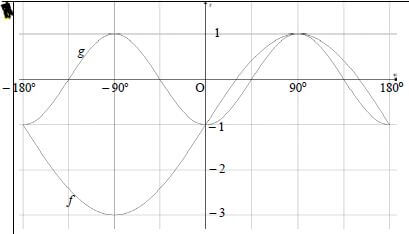 | ✓ turning point (–90° ; –3) |
| 6.2.2 | (−90°;0°) | ✓ ✓ answer (2) ✓ ✓ answer (2) |
| 6.2.3 | f(x) = g(x) ∴ -180º ; 0º; 90º; 180º f(x +30º) = g(x + 30º) ∴x = -30º; 60º ; 150º | ✓ any ONE correct ✓ other 2 correct (2) [13] |
QUESTION 7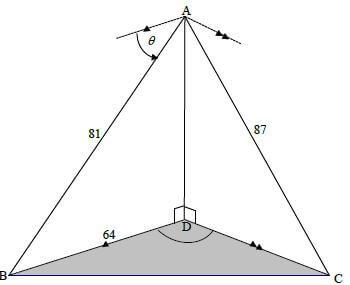
| 7.1 | ABD = θ [alternate∠s ; || lines] OR | ✓correct trig ratio
✓correct trig ratio |
| 7.2 | BC² = AB² + AC² - 2(AB)(AC)cosBAC =81² + 87² - 2(81)(87)cos82,6º =12312,754..... BC = 110,97m | ✓use cosine rule ✓correct substitution into cosine rule ✓answer (3) |
| 7.3 | sinDCB = sinBDC BD BC sinDCB = BD.sinBDC BC sinDCB = 64.sin110º 110,97 ∴DCB = 32,82º | ✓ use sine rule |
QUESTION 8
8.1 
| 8.1.1 | P = 32º [opp ∠ s of cyclic quad | ✓ S |
| 8.1.2 | O1 = 2(32º) = 64º [∠centre = 2∠ at circum ] OR reflex O = 296º [∠centre = 2∠ at circum] | ✓ S ✓R (2) ✓ S and R |
| 8.1.3 | OMS = 180º -(32º +18º +43º) [sum ∠ sΔ] = 87º | ✓ S ✓ S (2) |
| 8.1.4 | R3 = TMP = 87º + 18º - 6º =99º | ✓ R ✓ S (2) |
8.2 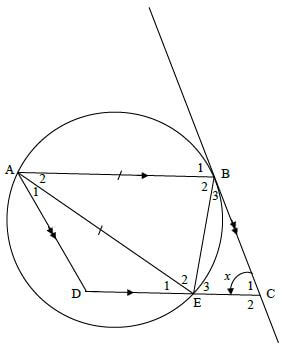
| 8.2.1 | corres ∠s; AB| | DC | ✓ R (1) |
| 8.2.2 | E2 = x [tan - chord theorem] Any 3 ∠s correct | ✓S ✓R ✓ S ✓ R ✓ S ✓ R (6 |
| 8.2.3 | D = 180º - x [co - int ∠s suppl ; AD || BC] OR DAB = x [OPP ∠s ||m] OR [alt ∠s ; BC|| AD] | ✓S ✓ R ✓S ✓ R |
QUESTION 9
| 9.1 | … in the alternate segment | ✓ answer (1) |
9.2 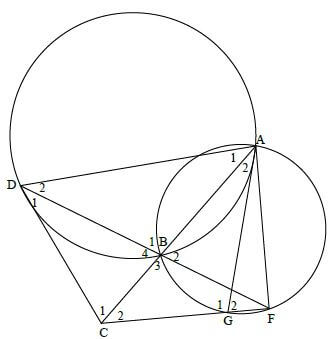
| 9.2.1 | A1 = D1 [tan chord theorem] B4 = A1 + D2 [ext ∠ Δ] =D1 + D2 | ✓S ✓ R ✓ S ✓ R (4) |
| 9.2.2 | B4 = B2 [vert opp ∠s] D1 + D2 = B2 [proven] =G2 [∠s in same segment] ∴ AGCD is cyc quad [converse ext ∠ cyc quad] | ✓ S ✓ S ✓ R ✓ R (4) |
| 9.2.3 | D1 = A2 [∠s in same segment] A2 = F [∠s in same segment] ∴ D1 = F ∴ DC = CF [side opp ∠s ] | ✓ S ✓ R ✓ S ✓ R (4) [13] |
QUESTION 10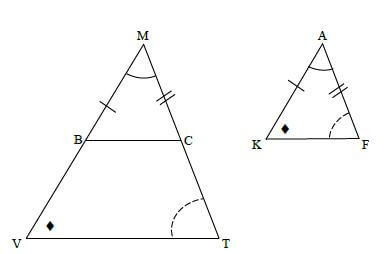
| 10.1 | Constr: Draw line BC such that MB = AK and MC = AF Proof: In ΔBMC and ΔKAF MB = AK [constr] M = A [given] MC = AF [constr] ΔBMC = ΔKAF [s∠s] ∴MBC = AKF or MCB = AFK [ΞΔ] but V = K or T = F [given] ∴MBC = V or MCB = T But these are corresponding ∠s ∴ BC || VT [corr∠s≡] ∴ MV = MT [prop theorem; BC || VT] MB MC but MB = AK and MC = AF [const] ∴ MV = MT AK AF | ✓ constr/konstr ✓ S / R
✓ S / R ✓S ✓R (7) |
10.2
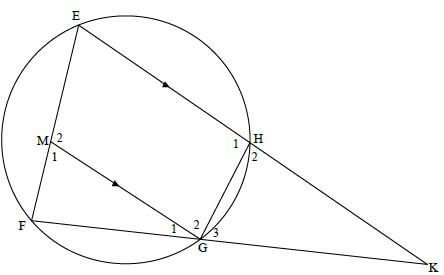
| 10.2.1 (a) | In ΔKGH and ΔKEF K is common H2 = F [ext ∠ CYCLIC QUAD] G3 = E [sum∠s Δ or ext∠cyclic quad] ∴ ΔKGH ||| ΔKEF [∠∠∠] | ✓ S ✓S ✓R ✓ naming third angle OR ∠∠∠ (4) |
| 10.2.1 (b) | EF = KE [||| Δs] GH KG ∴ EF = KE GH EF [KG = EF] ∴ EF2 = KE.GH | ✓ S ✓ S (2) |
| 10.2.1 (c) | KG = EM [prop theorem ; MG || EK] KF EF but EF = KG [given] KG = EM KF KG KG2 = EM.KF | ✓ S ✓ R ✓ S (3) |
| 10.2.2 | KE.GH = EM.KF EM = 20 × 4 16 =5 units | ✓ KE.GH = EM.KF ✓ substitution ✓ answer (3) [19] |
TOTAL: 150
GRADE 12 MATHEMATICS PAPER 2 QUESTIONS - SENIOR CERTIFICATE EXAMINATIONS PAST PAPER (QUESTIONS) 2016
Mathematics Paper 2
Grade 12
Senior Certificate Examinations
Past Paper (questions) 2016
INSTRUCTIONS AND INFORMATION
Read the following instructions carefully before answering the questions.
- This question paper consists of 10 questions.
- Answer ALL the questions.
- Clearly show ALL calculations, diagrams, graphs, et cetera that you have used in determining your answers.
- Answers only will not necessarily be awarded full marks.
- You may use an approved scientific calculator (non-programmable and non-graphical), unless stated otherwise.
- If necessary, round off answers to TWO decimal places, unless stated otherwise.
- Diagrams are NOT necessarily drawn to scale.
- An information sheet with formulae is included at the end of the question paper.
- Write neatly and legibly.
QUESTIONS
QUESTION 1
On a certain day a tour operator sent 11 tour buses to 11 different destinations. The table below shows the number of passengers on each bus.
| 8 | 8 | 10 | 12 | 16 | 19 | 20 | 21 | 24 | 25 | 26 |
1.1 Calculate the mean number of passengers travelling in a tour bus. (2)
1.2 Write down the five-number summary of the data. (3)
1.3 Draw a box and whisker diagram for the data. Use the number line provided in the ANSWER BOOK. (2)
1.4 Refer to the box and whisker diagram and comment on the skewness of the data set. (1)
1.5 Calculate the standard deviation for this data set. (2)
1.6 A tour is regarded as popular if the number of passengers on a tour bus is one standard deviation above the mean. How many destinations were popular on this particular day? (2)
[12]
QUESTION 2
On the first school day of each month information is recorded about the temperature at midday (in °C) and the number of 500 ml bottles of water that were sold at the tuck shop of a certain school during the lunch break. The data is shown in the table below and represented on the scatter plot. The least squares regression line for this data is drawn on the scatter plot.
2.1 Identify an outlier in the data. (1)
2.2 Determine the equation of the least squares regression line. (3)
2.3 Estimate the number of 500 ml bottles of water that will be sold if the temperature is 28 °C at midday. (2)
2.4 Refer to the scatter plot. Would you say that the relation between the temperature at midday and the number of 500 ml bottles of water sold is weak or strong? Motivate your answer. (2)
2.5 Give a reason why the observed trend for this data cannot continue indefinitely. (1)
[9]
QUESTION 3
In the diagram below (not drawn to scale) A(-8; 6), B(8; 10), C and D(-2; 0) are the vertices of a trapezium having BC|| AD. T is the midpoint of DB. From B, the straight line drawn parallel to the y-axis cuts DC in F[ 8;31/3] and the x-axis in M.
3.1 Calculate the gradient of AD. (2)
3.2 Determine the equation of BC in the form y= mx + c. (3)
3.3 Prove that BDI AD. (3)
3.4 Calculate the size of BÔM. (2)
3.5 If it is given that TC ||DM and points T and C are symmetrical about line BM, calculate the coordinates of C. (3)
3.6 Calculate the area of ABDF. (5)
[18]
QUESTION 4
A circle having C(3 ;-1) as centre and a radius of 10 units is drawn. PTR is a tangent to this circle at T. R(k;21), C and P are the vertices of a triangle. TR = 20 units. 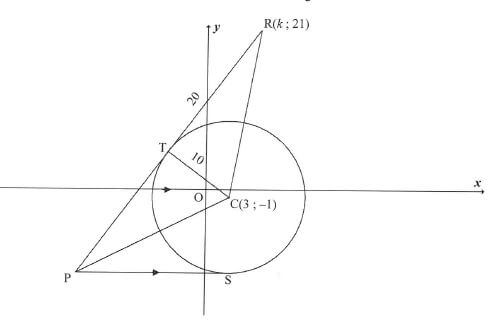
4.1 Give a reason why TC 1 TR.(1)
4.2 Calculate the length of RC. Leave your answer in surd form. (2)
4.3 Calculate the value of k if R lies in the first quadrant. (4)
4.4 Determine the equation of the circle having centre C and passing through T. Write your answer in the form (x -a)2 +(y- b)2 = r2 (2)
4.5 PS, a tangent to the circle at S, is parallel to the x-axis. Determine the equation of PS. (2)
4.6 The equation of PTR is 3y - 4x = 35
4.6.1 Calculate the coordinates of P.(2)
4.6.2 Calculate, giving a reason, the length of PT.(3)
4.7 Consider another circle with equation (x – 3)2 +(y+16)2 = 16 and having centre M.
4.7.1 Write down the coordinates of centre M. (1)
4.7.2 Write down the length of the radius of this circle. (1)
4.7.3 Prove that the circle with centre C and the circle with centre M do not intersect or touch. (3)
[21]
QUESTION 5
5.1 In the diagram PR ⊥ TS in obtuse triangle PTS.
PT = √5; TR = 2; PR = 1; PS = √10 and RS = 3 
5.1.1 Write down the value of:
(a) sin Î (1)
(b) cos ŝ (1)
5.1.2 Calculate, WITHOUT using a calculator, the value of cos(Τ + S) (5)
5.2 Determine the value of:
1 - tan2 (180º + θ) (6)
COS(360º - θ).sin(90º - θ)
5.3 If sin x - cos x = 3/4, , calculate the value of sin 2x WITHOUT using a calculator. (5)
[18]
QUESTION 6
6.1 Determine the general solution of 4sin x + 2 cos2x = 2
6.2 The graph of g(x) = -cos 2x for x € [-180º ; 180º) is drawn below. 
6.2.1 Draw the graph of f(x) = 2 sin x-1 for x€ [-180° ; 180°] on the set of axes provided in the ANSWER BOOK.(3)
6.2.2 Write down the values of x for which g is strictly decreasing in the interval x€[-180° ; 180°] (2)
6.2.3 Write down the value(s) of x for which f(x + 30°)- g (x + 30°) = 0 for x € [-180° ; 180°] (2)
[13]
QUESTION 7
From point A an observer spots two boats, B and C, at anchor. The angle of depression of boat B from A is 0. D is a point directly below A and is on the same horizontal plane as B and C. BD = 64 m, AB = 81 m and AC = 87 m.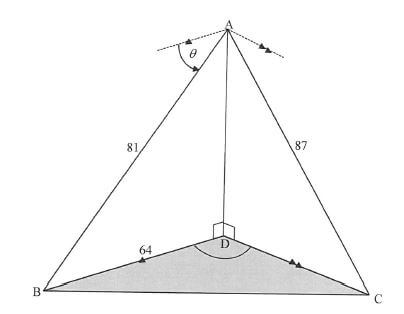
7.1 Calculate the size of θ to the nearest degree. (3)
7.2 If it is given that BÂC = 82,6º, calculate BC, the distance between the boats. (3)
7.3 If BỘC = 110º, calculate the size of DĈB. (3)
[9]
Give reasons for ALL statements in QUESTIONS 8, 9, 10 and 11.
QUESTION 8
8.1 In the diagram below, P, M, T and R are points on a circle having centre 0. PR produced meets MS at S. Radii OM and OR and the chords MT and TR are drawn. Τ1= 148°, PMO=18° and Ŝ= 43°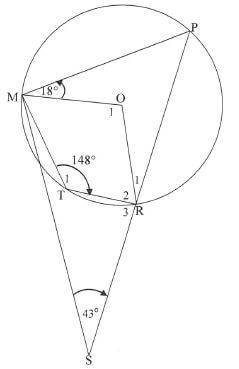
Calculate, with reasons, the size of:
8.1.1 P (2)
8.1.2 O1 (2)
8.1.3 OMS (2)
8.1.4 R3, if it is given that TMS= 6° (2)
8.2 In the diagram below, the circle passes through A, B and E. ABCD is a parallelogram. BC is a tangent to the circle at B. AE = AB. Let Ĉ1 = x 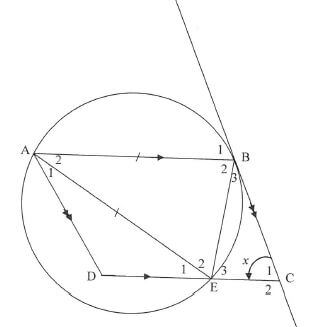
8.2.1 Give a reason why B1 = x (1)
8.2.2 Name, with reasons, THREE other angles equal in size to x. (6)
8.2.3 Prove that ABED is a cyclic quadrilateral. (3)
[18]
QUESTION 9
9.1 Complete the statement so that it is TRUE:
The angle between the tangent to a circle and the chord drawn from the point of contact is equal to the angle ... (1)
9.2 In the diagram below, two unequal circles intersect at A and B. AB is produced to C such that CD is a tangent to the circle ABD at D. F and G are points on the smaller circle such that CGF and DBF are straight lines. AD and AG are drawn.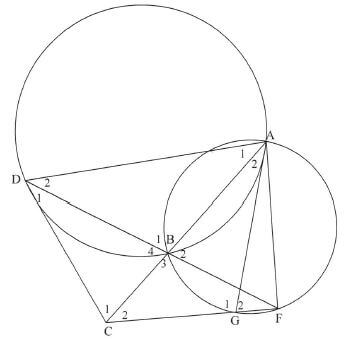
Prove that:
9.2.1 B4 =D1 +D2 (4)
9.2.2 AGCD is a cyclic quadrilateral (4)
9.2.3 DC = CF (4)
[13]
QUESTION 10
10.1 In the diagram below, ΔMVT and ΔAKF are drawn such that M =Â, V =K and T = F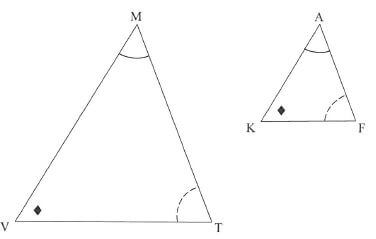
Use the diagram in the ANSWER BOOK to prove the theorem which states that if two triangles are equiangular, then the corresponding sides are in proportion,
that is: MV = MT
AK AF
10.2 In the diagram below, cyclic quadrilateral EFGH is drawn. Chord EH produced and chord FG produced meet at K. M is a point on EF such that MG || EK. Also KG = EF 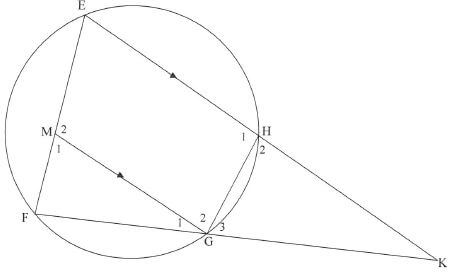
10.2.1 Prove that:
(a) ΔKGH ||| ΔKEF (4)
(b) EF2 = KE .GH (2)
(c) KG2 = EM . KF (3)
10.2.2 If it is given that KE = 20 units, KF = 16 units and GH = 4 units, calculate the length of EM. (3)
[19]
TOTAL: 150
INFORMATION SHEET
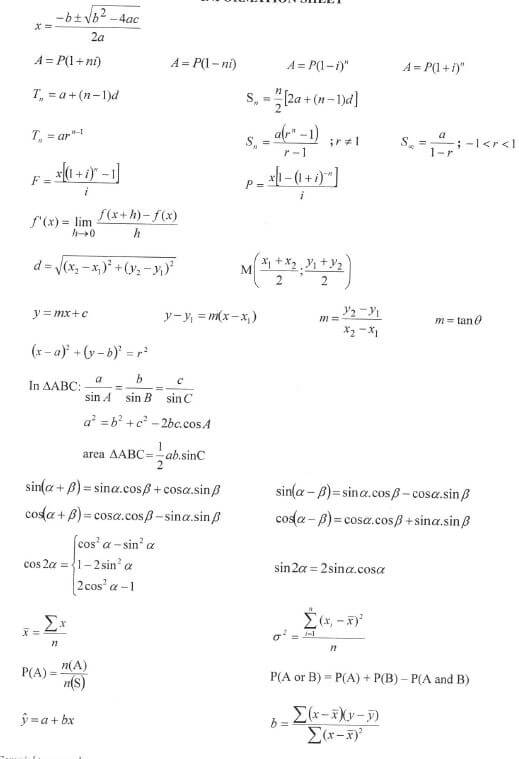
GRADE 12 MATHEMATICS PAPER 2 MEMORANDUM - SENIOR CERTIFICATE EXAMINATIONS PAST PAPERS AND MEMOS MAY/JUNE2016
Mathematics Paper 1
Grade 12
Senior Certificate Examinations
Past Paper (memorandum) 2016
NOTE:
- If a candidate answers a question TWICE, only mark the FIRST attempt.
- Consistent accuracy applies in ALL aspects of the marking memorandum.
MEMORANDUM
QUESTION 1
| 1.1.1 | 4x2 - 25 = 0 OR 4x2 = 25 | ✓✓ factors
✓ answers (3)
✓ x2 = 25/4 ✓ x = ± √25/4 ✓ answer (3) |
| 1.1.2 | x2 - 5x - 2 = 0 OR x2 - 5x + 25/4 = 2 + 25/4 | ✔ correct substitution into correct formula
✔ answer ✔ answer (3)
✔ for adding 25/4 on both sides
✔answer ✔answer (3) |
| 1.1.3 |  | ✔method
✔critical values in context of inequality ✔inequality or interval (3)
✔change of inequality ✔critical values in context of inequality ✔inequality or interval (3) |
| 1.1.4 | x - 3x½ - 4 = 0 OR x - 3x½ - 4 = 0 OR x - 3x½ = 4 | ✔ standard form ✔ standard form ✔ factors ✔ isolating 3√x or 3x½ ✔ factors |
| 1.2 | y = 2x +1 OR x = y - 1 | ✔ y subject of formula
✔ standard form
✔ x subject of formula |
| 1.3.1 | 2x + 1 ≥ 0 OR | ✔ answer (1)
✔ answer (1) |
| 1.3.2 | f(x) = 2x -1 √2x +1 = 2x -1 Restrictions 2x + 1 = 4x2 - 4x +1 x ≥ -½ and x ≥ ½ 4x2 - 6x = 0 x (4x -6) = 0 x = 3/2 or x = 0 ∴x = 3/2 | ✔ √2x +1 = 2x −1 ✔ standard form |
QUESTION 2
| 2.1.1 | 27 - b = b - 13 OR 27 - 13 = 2d | ✔ 27 − b = b −13
✔ 27 − 20 =13− a (2)
✔ d = 7 or 27 −13 = 2d ✔b = 13 + 7 |
| 2.1.2 | a = 6 d = 7 OR T20 = a + 19(d) | ✔ d = 7 ✔answer (3)
✔ d = 7
✔answer (3) |
| 2.1.3 | Tn= 6 + (n -1)(7) = 7n - 1 20 ∑ (6 + 7 (n -1)) n-1 20 = ∑ (7n -1) n-1 | ✔Tn= 6 + (n -1)(7) or 7n - 1 (2) |
| 2.2.1 | r = (x -2) (x + 2) x -2 or r = (x2 - 4) (x +2) x2 - 4 For convergence -1 < r < 1 -1 < x + 2 < 1 -3 < x < -1 | ✔ (x -2) (x + 2) or = (x2 - 4) (x +2)
|
| 2.2.2 | OR
| ✔a = − 7/2
✔ substitution into correct formula ✔ substitution of x = − 3/2 ✔answer (3) [14] |
QUESTION 3
| 3.1 |
OR Tn = T1 + (n -1) d1 + (n - 1)(n - 2) d2 |
✔2nd difference = 4
✔ formula ✔Tn = 2n2 - 3n (4) |
| 3.2 | Tn = 2n2 - 3n T48 = 2(48)2 - 3(48) =4464 | ✔ substitution |
| 3.3 | 3 + 7 +11.......... Sn = n/2 [2a + (n -1) d] = n/2 [2(3) + (n -1) 4] =n/2 [6 + 4n - 4] =2n2 + n | ✔ a = 3 |
| 3.4 | S69 = 9591 and T1 = -1 OR 2n2 - 3n = 9590 | ✔(9591)+ (−1) ✔ 2n2 - 3n - 9590 = 0 ✔70 (2) |
QUESTION 4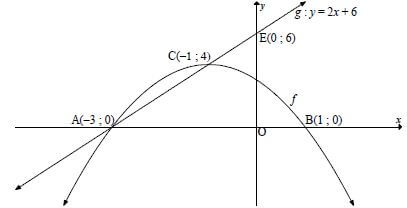
| 4.1 | (0 ; 3) | ✔ (0 ; 3) (1) |
| 4.2 | x = - b /2a or -2x -2 = 0
y = -(-1)2 -2(-1) + 3 or y = 4ac - b2 | ✔x = -2x -2 = 0 or - (-2) ✔ simplification
✔ in the context of a turning point (3) |
| 4.3 | B (1 ; 0) By symmetry A (-3 ; 0) OR x2 + 2x -3 = 0 | ✔ A(− 3 ; 0) (1)
✔ A(− 3 ; 0) (1) |
| 4.4 | Equation of g: y = 2x + q or y - 0 = 2(x + 3) E(0 ; 6) | ✔ m = 2
✔ y = 2x + 6
✔ E(0 ;6) |
| 4.5 | f'(x) = -2x -2 But mtan = 2 OR | ✔ − 2x − 2 ✔ y = 3 ✔answer (5)
✔ -x2 - 2x + 3 = 2x + k ✔ b2 - 4ac = 0 |
| 4.6 | g : y = 2x + 6 g-1 : x = 2y + 6 2y = x - 6 y = x - 6 or y = x - 3 2 2 | ✔ x = 2y + 6 ✔ y = x - 6 or y = x - 3 |
| 4.7 | g(x) ≥ g-1 (x) 2x + 6 ≥ x - 6 2 4x + 12 ≥ x - 6 3x ≥ -18 x ≥ -6 | ✔2x + 6 ≥ x - 6 |
QUESTION 5
| 5.1 | r = 2 | ✔r = 2 (1) |
| 5.2 | g(x) = 2x + 2 3 = 3 + 2 | ✔ g(0) = 2º + 2 = 3 ✔substitute B(0 ; 3) and q = 2 ✔ p = −3 (4) |
| 5.3 | at A: x = −3 y = 2-3 + 2 = 21/8 | ✔ at A : x = –3 (p-value) ✔ substitute x = –3 into exponential eqution ✔ y-value (3) |
| 5.4 | − 3 < x ≤ 0 OR (− 3; 0] | ✔ − 3 < x ✔ x ≤ 0 (2) |
| 5.5 | f (x) = 3 + 2 x + 3 f (x - 2) = 3 + 2 x - 2+ 3 h(x) = 3 + 2 x + 1 | ✔substitution of x – 2 |
QUESTION 6
| 6.1 | A= P (1 -i )n 2/3P = P( 1- 0,047)n 2/3 = (1- 0,047)n log 2/3 = nlog (1- 0,047) n = log2/3 log (1- 0,047) n = 8, 42 years | ✔A = 2/3P ✔logs |
| 6.2.1 | The book value of the tractor after 5 years book value = x(1 - 0,2)5 or x(0,8)5 =0, 32768x | ✔x(1 - 0,2)5 or x(0,8)5 ✔ 0,32768x (2) |
| 6.2.2 | Price of new tractor after 5 years book value = x(1 + 0,18)5 or x(1,18)5 =2,28776x | ✔ x(1 + 0,18)5 or x(1,18)5 ✔ 2,28776x (2) |
| 6.2.3 | 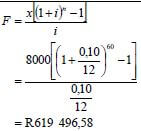 | ✔ i = 0,10/12 ✔ n = 60 ✔ subst. into future value formula ✔ answer (4) |
| 6.2.4 | Sinking fund = New tractor price – Scrap value OR 619496,58 =x(2,28776) -x(0,32768) | ✔ 619496,58
✔ R316 000 (4)
✔ 619496,58 ✔ R316 000 (4) |
QUESTION 7
| 7.1 | f(x + h) = 3(x +h)2 - 5 = 3(x2 + 2xh +h2) - 5 =3x2 + 6xh + 3h2 -5 f(x + h) - f(x) = 3x2 + 6xh + 3h2 - 5 - 3x2 +5 = 6xh + 3h2 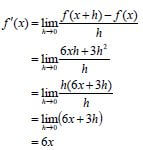 OR 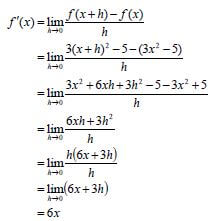 | ✔3x2 + 6xh + 3h2 - 5 ✔ f(x + h) - f(x) ✔ common factor/ (6x + 3h) ✔ answer (5)
✔ f(x + h) - f(x) ✔ 3x2 + 6xh + 3h2 - 5 ✔ 6xh + 3h2 ✔ common factor/(6x + 3h)
✔ answer (5) |
| 7.2.1 | y = 2x5 + 4/x3 y = 2x5 + 4x-3 dy /dx = 10x4 - 12x-4 | ✔ 2x5 + 4x-3 ✔ 10x4 ✔ - 12x-4 (3) |
| 7.2.2 | y = ( √x -x2)2 y = x½ - x2)2 =x - 2x 5/2 + x4 dy /dx = 1 - 5x 3/2 + 4x3 | ✔ x - 2x 5/2 + x4 |
QUESTION 8
| 8.1 | y = 12 | ✔answer (1) |
| 8.2 | 12 = (0 - 2)2(0 -k) (x - 2)2(x + 3) = 0 y = 0 | ✔ substituting (0;12) ✔ k = −3
✔ x = −3 (3)
✔–4k |
| 8.3 | f(x) = x3 + 3x2 - 4x2 - 12x + 4x +12 3x2 - 2x - 8 = 0 C[ -4/3 ; 18,52] | ✔ f(x) = x3 - x2 - 8x + 12 ✔derivative (6) |
| 8.4 | f''(x) = 6x - 2 OR f''(x) = 6x - 2 OR x = xe + xd = -4/3 + 2 | ✔ 6x − 2 ✔✔x < 1/3 (3)
✔ 6x − 2
✔✔x < 1/3 (3)
✔= -4/3 + 2 ✔✔x < 1/3 (3) |
QUESTION 9
| 9.1 | V = π r2h π r2h = 340 h = 340 π r2 | ✔formula ✔equating to 340 ✔ h = 340 |
| 9.2 | A = 2π r2 + 2π rh A'(r) = 0 for minimum surface area | ✔ 2π r2 + 2π rh |
QUESTION 10
| 10.1.1 (a) | P(Female) = 70 = 7 = 0,47 150 15 | ✔ 70 |
| 10.1.1 (b) | P(Female playing tennis) = 20 = 2 = 0,13 150 15 | ✔ answer (1) |
| 10.1.2 | P(Female) = 70 150 P(Playing) = 70 150 P(Female playing tennis) = 20 = 2 = 0,13 150 15 P(Female) × P(Playing) = 70 × 70 = 4900 = 0,22 150 150 22500 P(Female playing tennis) ≠ P(Female) × P(Playing) Therefore the event of playing tennisis not independent of gender. OR P(Male) = 80 P(Male playing tennis) ≠P(Male/Manlik) × P(Playing) OR P(Male) = 80 OR P(Female) = 70 P(Female not playing tennis) = 50 = 0,33333 | ✔P(Play ten) = 70 ✔ = 70 × 70 = 4900 = 0,22 ✔P(Female playing tennis) ≠ P(Female) × P(Playing) Not independent (3)
✔P(Playing) = 70 ✔ = 80 × 70 = 5600 = 0,25 ✔P(Male playing tennis) ≠P(Male/Manlik) × P(Playing)
✔ P(Not playing tennis) = 80
✔ P(not play ten) = 80 |
| 10.2 | P(B) = 1 - P(B') P(A or B) = P(A) + P(B) - P(A and B) | ✔ P(B) = 0,72 ✔ P(A) = 0,24 ✔ substitution into correct formula |
QUESTION 11
| 11.1 | 2 × 2! × 7! = 20 160 | ✔ 2 × 2! |
| 11.2 | All seated in 9! = 362 880 ways Girls seated together in 4! ways. P(all girls seated together) | ✔ 9! or 362 880 ✔ 4! 6! or 17280
✔ 17280 or 0,047619 21 or |
| TOTAL | 150 |
